Article Catalog
In order to illustrate the testing and dataset adaptation of these SLAM frameworks above, the M2DGR dataset is taken as an example for the respective configuration and running, which is convenient for me to adapt my own dataset in the future.The SLAM frameworks that are run include: ORB-SLAM2, ORB-SLAM3, VINS-Mono, A-LOAM, LeGO-LOAM, LIO-SAM, LVI -SAM, FAST-LIO2, FAST-LIVO, Faster-LIO, hdl_graph_slam. The experiment is based on Ubuntu 20.04, in which the installation of ORB, VINS-Mono, and LOAM series refer to my previous blog, with detailed installation methods, and the other frameworks will be briefly introduced later to the installation methods
Because the learning is not deep enough, the main purpose is to record the parameter configuration method, some parameter configuration may be wrong and lead to data running problems.If you find any errors or problems, please feel free to discuss themI’ll fix it.
I. The M2DGR dataset
M2DGRis a novel large-scale dataset collected by a ground-based robot with a complete sensor suite including six fisheye and one sky-pointing RGB cameras, infrared cameras, event cameras, visual inertial sensors (VI-sensors), inertial measurement units (IMUs), LiDARs, consumer-grade Global Navigation Satellite System (GNSS) receivers, and a real-time kinetic (RTK) signaling GNSS-IMU navigation system. All of these sensors are well calibrated and synchronized and their data is recorded simultaneously. The trajectory truth values were obtained by motion capture equipment, laser 3D tracker and RTK. The dataset consists of 36 sequences (about 1 TB) that were captured in different scenarios including indoor and outdoor environments.
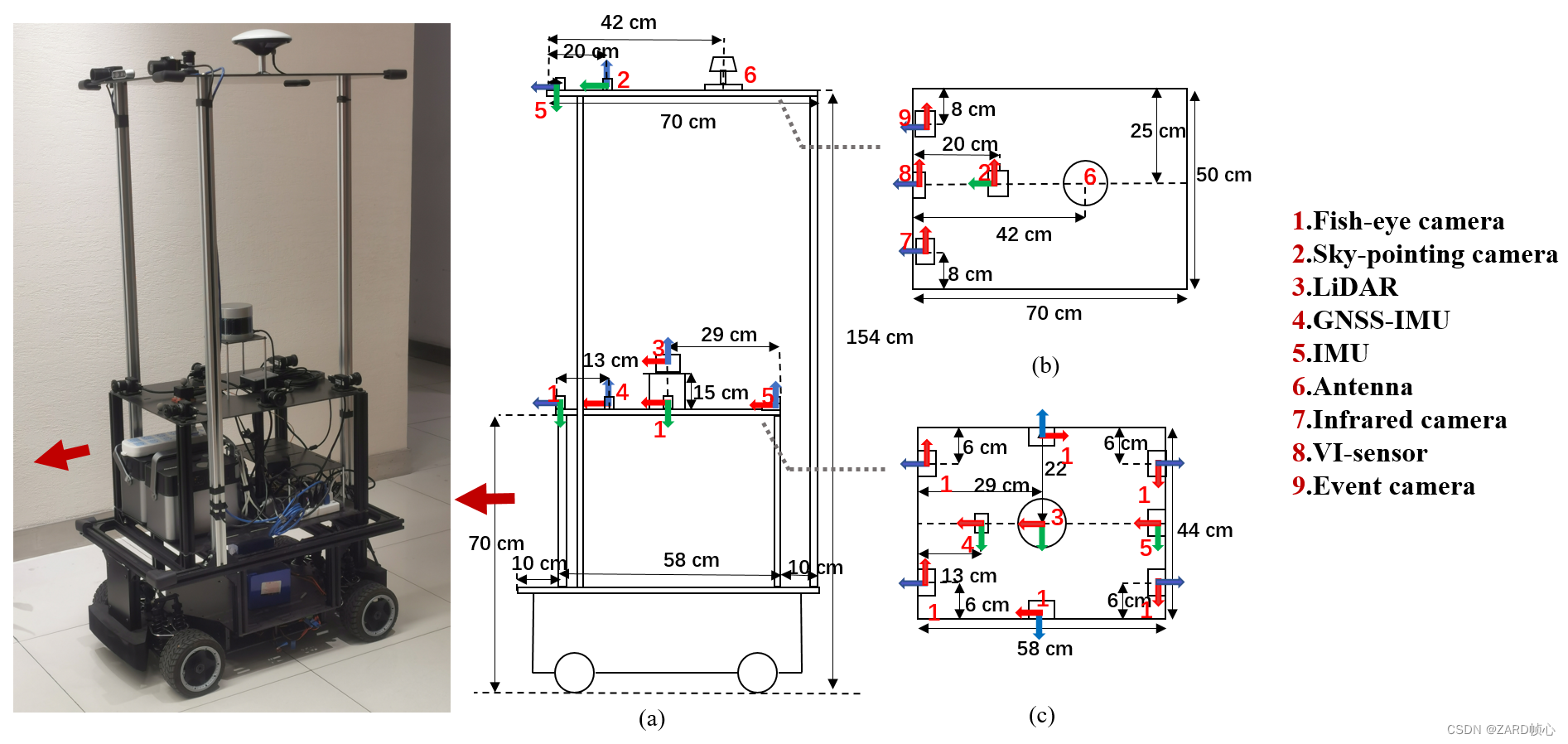
The sensor parameters are as follows:
- LIDAR Velodyne VLP-32C, 360 Horizontal Field of View (FOV),-30 to +10 vertical FOV,10Hz,Max Range 200 m,Range Resolution 3 cm, Horizontal Angular Resolution 0.2°.
- RGB Camera FLIR Pointgrey CM3-U3-13Y3C-CS,fish-eye lens,1280*1024,190 HFOV,190 V-FOV, 15 Hz
- GNSS Ublox M8T, GPS/BeiDou, 1Hz
- Infrared Camera,PLUG 617,640*512,90.2 H-FOV,70.6 V-FOV,25Hz;
- V-I Sensor,Realsense d435i,RGB/Depth 640*480,69H-FOV,42.5V-FOV,15Hz;IMU 6-axix, 200Hz
- Event Camera Inivation DVXplorer, 640*480,15Hz;
- IMU,Handsfree A9,9-axis,150Hz;
- GNSS-IMU Xsens Mti 680G. GNSS-RTK,localization precision 2cm,100Hz;IMU 9-axis,100 Hz;
- Laser Scanner Leica MS60, localization 1mm+1.5ppm
- Motion-capture System Vicon Vero 2.2, localization accuracy 1mm, 50 Hz;
Later we have to configure the parameters, refer to the calibration filecalibration_results.txt, each data topic of the rosbag sequence is as follows:
- LIDAR:
/velodyne_points - RGB Camera:
/camera/left/image_raw/compressed,
/camera/right/image_raw/compressed,
/camera/third/image_raw/compressed,
/camera/fourth/image_raw/compressed,
/camera/fifth/image_raw/compressed,
/camera/sixth/image_raw/compressed,
/camera/head/image_raw/compressed - GNSS Ublox M8T:
/ublox/aidalm,
/ublox/aideph,
/ublox/fix,
/ublox/fix_velocity,
/ublox/monhw,
/ublox/navclock,
/ublox/navpvt,
/ublox/navsat,
/ublox/navstatus,
/ublox/rxmraw - Infrared Camera:
/thermal_image_raw - V-I Sensor:
/camera/color/image_raw/compressed,/camera/imu - Event Camera:
/dvs/events,/dvs_rendering/compressed - IMU:
/handsfree/imu
utilizationstreet_02.bagTo test the individual codes, we first pass therqt_bagcommand to visualize the bag, you can see that the time synchronization of this data is not very good
roscore
rqt_bag street_02.bag
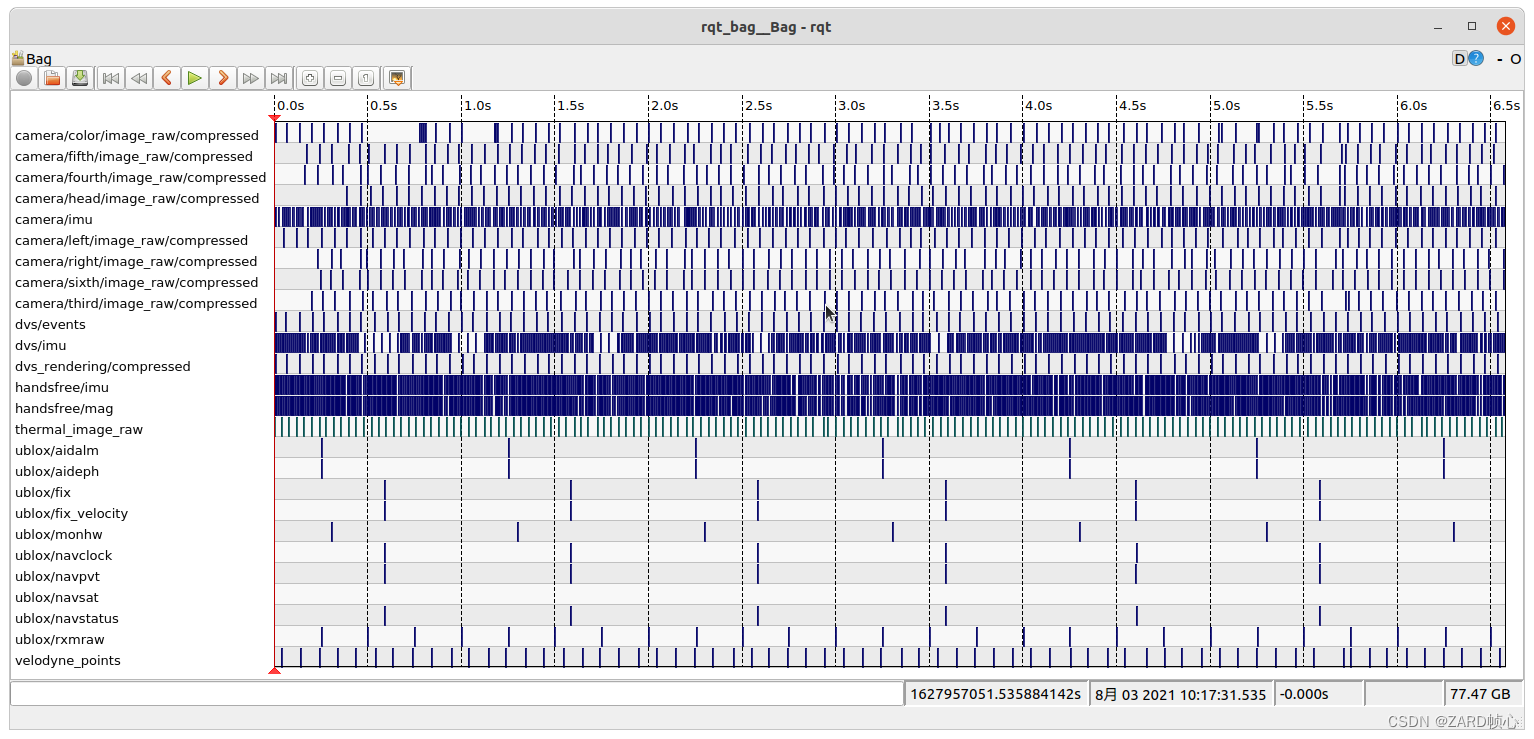
(ii) ORB-SLAM2
2.1 Configuration parameters
inExamples/Monocular/Add a parameter file to the folderM2DGR.yamlmodeled afterExamples/Monocular/TUM1.yamlFile modification parameters, mainly modify the camera internal parameters, the rest of the parameters adjusted as needed
# Camera calibration and distortion parameters (OpenCV)
Camera.fx: 617.971050917033
Camera.fy: 616.445131524790
Camera.cx: 327.710279392468
Camera.cy: 253.976983707814
Camera.k1: -0.28340811
Camera.k2: 0.07395907
Camera.p1: 0.00019359
Camera.p2: 1.76187114e-05
Camera.width: 640
Camera.height: 480
# Camera frames per second
Camera.fps: 15.02.2 Monocular
According to the image message above, the monocularros_mono.ccFile subscriptions.
//ros::Subscriber sub = nodeHandler.subscribe("/camera/image_raw", 1, &ImageGrabber::GrabImage,&igb);
// Replace with:
ros::Subscriber sub = nodeHandler.subscribe("/camera/color/image_raw", 1, &ImageGrabber::GrabImage,&igb);Recompile ros node
./build_ros.sh
Open four terminals and run each
roscore
# Open a terminal in the ORB_SLAM2 directory and run ORB-SLAM2
rosrun ORB_SLAM2 Mono Vocabulary/ORBvoc.txt Examples/Monocular/M2DGR.yaml
# **Note**: the image in the bag is in compressed format, use the image_transport package to decompress the image
rosrun image_transport republish compressed in:=/camera/color/image_raw raw out:=/camera/color/image_raw
# Open a terminal in the folder where bag is located and start playing the dataset:
rosbag play street_02.bagThe problem with pure vision is that it is slow to initialize and particularly susceptible to tracking loss (too fast motion, exposure, and interference from dynamic objects), in addition to severe single-purpose scale drift, which fails completely

The scale becomes smaller and squeezes a lump!
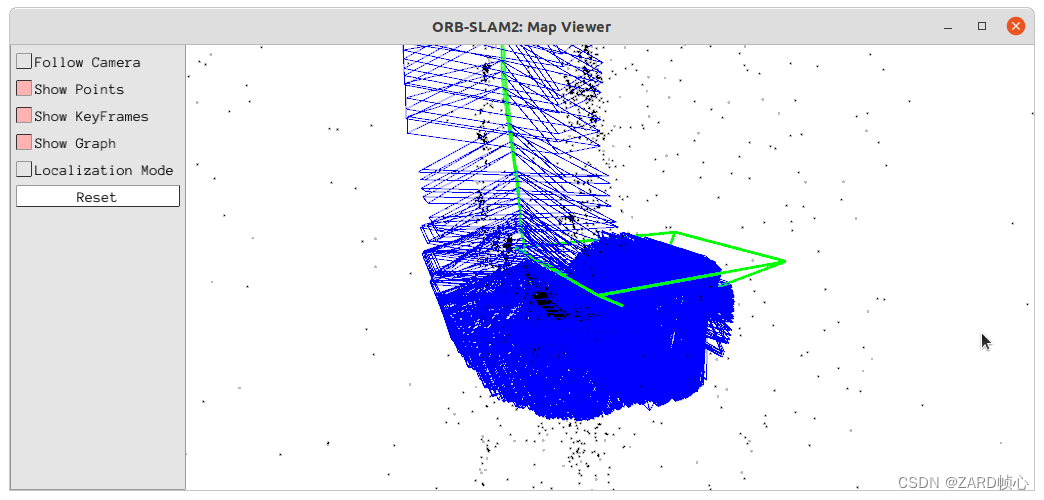
Three, ORB-SLAM3
3.1 Configuration parameters
inExamples/Monocular-Inertial/Add a parameter file to the folderUrbanNav.yamlmodeled afterExamples/Monocular-Inertial/EuRoC.yamlDocumentation, based onzed2_intrinsics.yaml、xsens_imu_param.yamlandextrinsic.yamlFile modification parameters, mainly modify the camera and IMU internal parameters and joint calibration, the rest of the parameters are adjusted as required
Camera.type: "PinHole"
# Camera calibration and distortion parameters (OpenCV)
Camera.fx: 617.971050917033
Camera.fy: 616.445131524790
Camera.cx: 327.710279392468
Camera.cy: 253.976983707814
Camera.k1: 0.148000794688248
Camera.k2: -0.217835187249065
Camera.p1: 0.0
Camera.p2: 0.0
Camera.width: 640
Camera.height: 480
# Camera frames per second
Camera.fps: 15.0
# Color order of the images (0: BGR, 1: RGB. It is ignored if images are grayscale)
Camera.RGB: 1
# Transformation from camera to body-frame (imu)
Tbc: !!opencv-matrix
rows: 4
cols: 4
dt: f
data: [0.0, 0.0, 1.0, 0.57711,
-1.0, 0.0, 0.0, -0.00012,
0.0, -1.0, 0.0, 0.83333,
0.0, 0.0, 0.0, 1.0]
# IMU noise
IMU.NoiseGyro: 2.1309311394972831e-02 #1.6968e-04
IMU.NoiseAcc: 1.2820343288774358e-01 #2.0e-3
IMU.GyroWalk: 3.6603917782528627e-04
IMU.AccWalk: 1.3677912958097768e-02
IMU.Frequency: 1503.2 Operational monocular + IMU
Modify ros_mono_inertial.cc’s IMU with image message subscription to:
// ros::Subscriber sub_imu = n.subscribe("/imu0", 1000, &ImuGrabber::GrabImu, &imugb);
// ros::Subscriber sub_img0 = n.subscribe("/cam0/image_raw", 100, &ImageGrabber::GrabImage,&igb);
ros::Subscriber sub_imu = n.subscribe("/handsfree/imu", 1000, &ImuGrabber::GrabImu, &imugb);
ros::Subscriber sub_img0 = n.subscribe("/camera/color/image_raw", 100, &ImageGrabber::GrabImage,&igb);Compile, then run
./build_ros.sh
# Configure the environment:
source Examples/ROS
Open a terminal in the #ORB_SLAM3 directory and run ORB-SLAM3
rosrun ORB_SLAM3 Mono_Inertial Vocabulary/ORBvoc.txt Examples/Monocular-Inertial/M2DGR.yaml
# **Note**: the image in the bag is in compressed format, use the image_transport package to decompress the image
rosrun image_transport republish compressed in:=/camera/color/image_raw raw out:=/camera/color/image_raw
# Open a terminal in the folder where bag is located and start playing the dataset:
rosbag play street_02.bagYou can see that the drift is very severe and there are scale changes during the run. No cause was analyzed (guessing it could be the/camera/color/image_raw(timestamp jumps too badly), and will be analyzed in more detail later. Anyway, the run failed
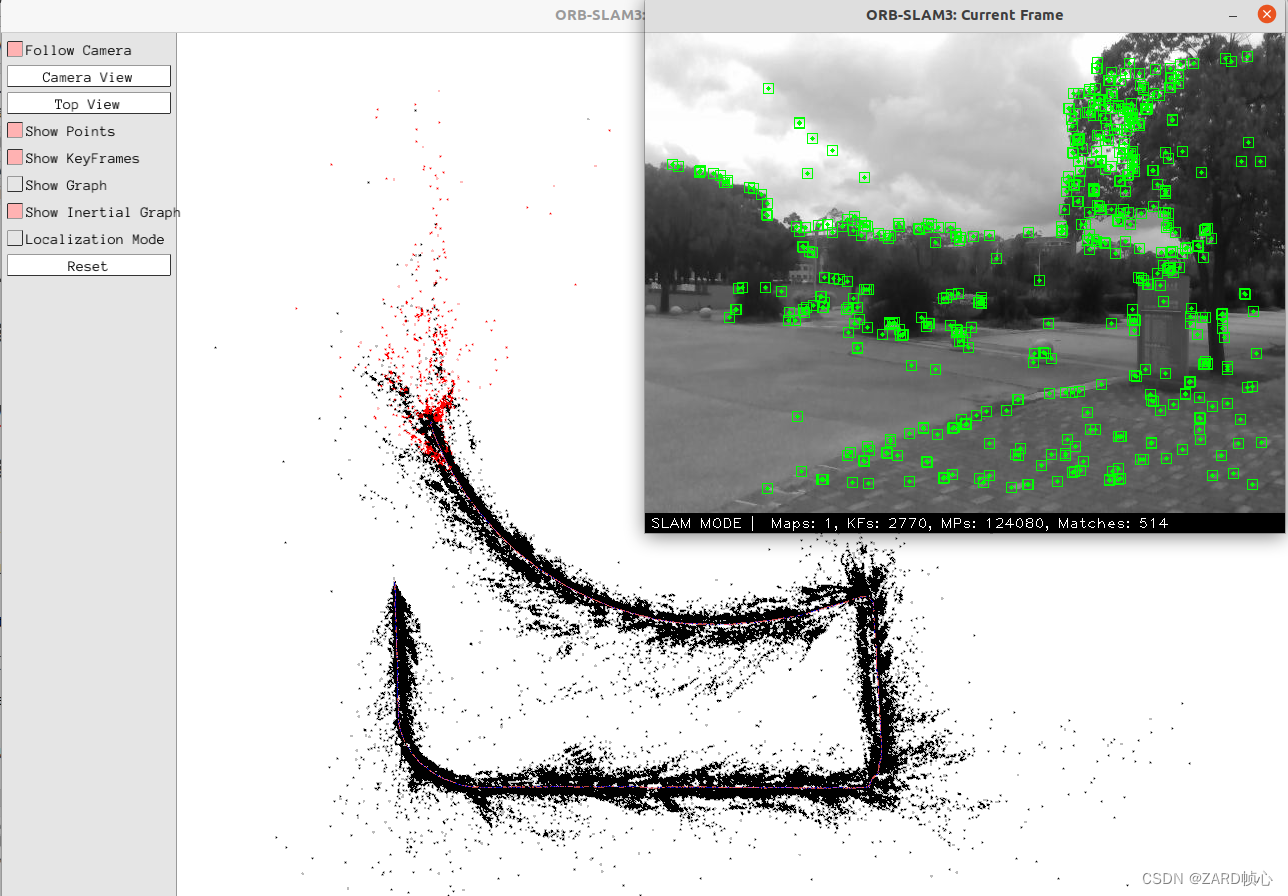
4, VINS-Mono
4.1 Configuration parameters
inconfigAdd a parameter file to the folderM2DGR.yamlmodeled afterconfig/euroc/euroc_config.yamlDocumentation, based onmy_params_camera.yamlFile modification parameters, mainly to modify the image and IMU data topics, results output path, camera and IMU internal parameters and joint calibration results, and the rest of the parameters are adjusted as needed.
#common parameters
imu_topic: "/handsfree/imu"
image_topic: "/camera/color/image_raw"
output_path: "/home/zard/Downloads/VINS-Mono"
# camera model
model_type: PINHOLE
camera_name: camera
image_width: 640
image_height: 480
distortion_parameters:
k1: 0.148000794688248
k2: -0.217835187249065
p1: 0.0
p2: 0.0
projection_parameters:
fx: 617.971050917033
fy: 616.445131524790
cx: 327.710279392468
cy: 253.976983707814
#imu parameters The more accurate parameters you provide, the worse performance
acc_n: 1.2820343288774358e-01 # accelerometer measurement noise standard deviation. #0.2
gyr_n: 2.1309311394972831e-02 # gyroscope measurement noise standard deviation. #0.05
acc_w: 1.3677912958097768e-02 # accelerometer bias random work noise standard deviation. #0.02
gyr_w: 3.6603917782528627e-04 # gyroscope bias random work noise standard deviation. #4.0e-5
g_norm: 9.805 # gravity magnitude
# Extrinsic parameter between IMU and Camera.
estimate_extrinsic: 0 # 0 Have an accurate extrinsic parameters. We will trust the following imu^R_cam, imu^T_cam, don't change it.
# 1 Have an initial guess about extrinsic parameters. We will optimize around your initial guess.
# 2 Don't know anything about extrinsic parameters. You don't need to give R,T. We will try to calibrate it. Do some rotation movement at beginning.
#Rotation from camera frame to imu frame, imu^R_cam
extrinsicRotation: !!opencv-matrix
rows: 3
cols: 3
dt: d
data: [ 0.0, 0.0, 1.0,
-1.0, 0.0, 0.0,
0.0, -1.0, 0.0]
#Translation from camera frame to imu frame, imu^T_cam
extrinsicTranslation: !!opencv-matrix
rows: 3
cols: 1
dt: d
data: [0.57711, -0.00012, 0.83333]imitatevins_estimator/launch/euroc.launchincreasevins_estimator/launch/M2DGR.launchStart the file, change the path to the parameter file, and be careful not to forget the command to decompress the image
<!-- <arg name="config_path" default = "$(find feature_tracker)/../config/euroc/euroc_config.yaml" /> -->
<arg name="config_path" default = "$(find feature_tracker)/../config/M2DGR.yaml" />
<! -- Image decompression -->
<node pkg="image_transport" type="republish" name="image_republish" args="compressed in:=/camera/color/image_raw raw out:=/camera/color/image_raw" output="screen" respawn="true"/>4.2 Operational monocular + IMU
Open three terminals, source and then type in
# Run the feature_tracker node and the estimator node, subscribe to the image and IMU data, and publish bitmap, 3D feature point, etc. to RVIZ for display.
source devel/setup.bash
roslaunch vins_estimator M2DGR.launch
# rviz visualization node
source devel/setup.bash
roslaunch vins_estimator vins_rviz.launch
# Open a terminal in the folder where bag is located and start playing the dataset:
rosbag play street_02.bagThe red trace is the front-end odometer, the green trace is the result of local optimization and loopback, this data has no loopback and has a large drift (guessing it’s also an image timestamp issue)
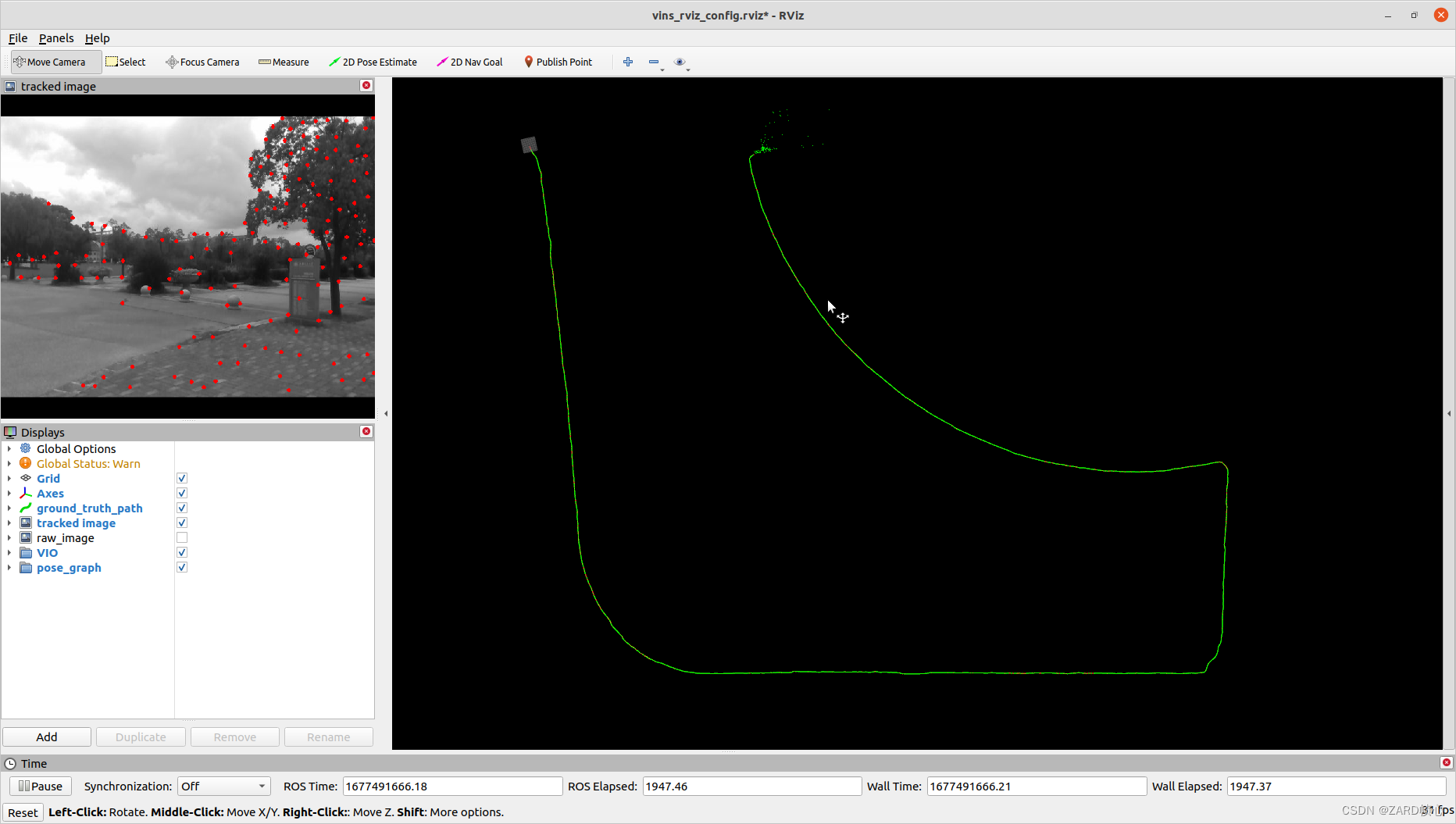
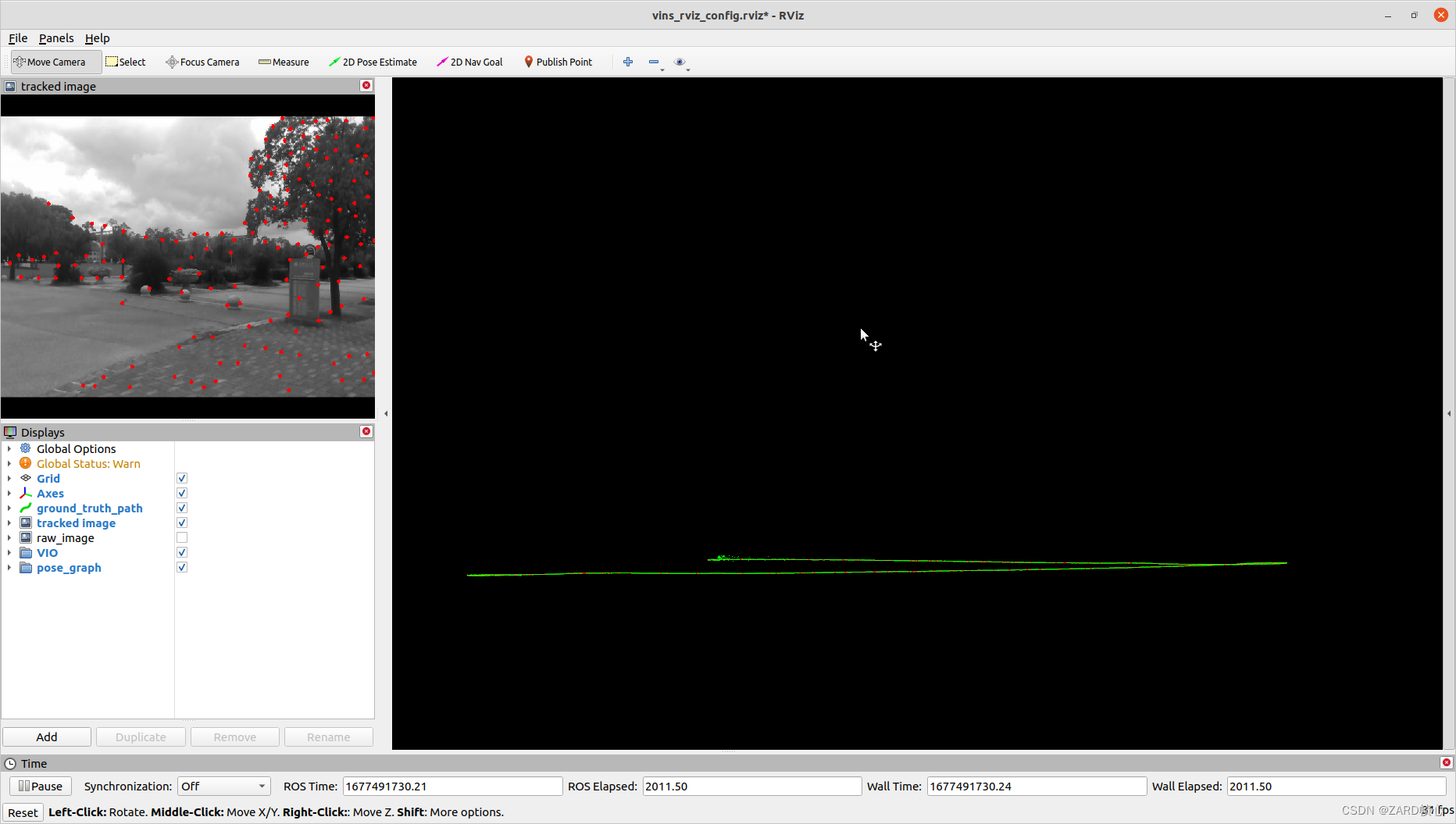
V. DM-VIO
5.1 Installation
Installation of gtsam, OpenCV and pangolin is not repeated, and DM-VIO is compiled directly:
git clone https://github.com/lukasvst/dm-vio.git
cd dm-vio
mkdir build && cd build
cmake ..
make -j8After compiling, you can see the executable dmvio_dataset in the build/bin directory, next install the ros plugin. Go to a random directory, the recommended one is a subdirectory of the dm-vio you just installed:
git clone https://github.com/lukasvst/dm-vio-ros.gitIn order for this plugin to find the dm-vio.bashrc just compiled add an environment variable:
sudo gedit ~/.bashrc
# Add at the end.
export DMVIO_BUILD=/YOURPATH/dm-vio/buildinCMakeLists.txtAdd it after line 85, otherwise the compiler will report an error because it can’t find the generated msg format:
add_dependencies(${PROJECT_NAME}_node ${PROJECT_NAME}_generate_messages_cpp)Compile:
catkin_make
source devel/setup.bash5.2 Configuration runs
The first step is to add the M2DGR camera model to config:
echo -e "RadTan 617.971050917033 616.445131524790 327.710279392468 253.976983707814 0.148000794688248 -0.217835187249065 0.0 0.0\n640 480\nfull\n640 480\n" > M2DGR.txtmodeled oneuroc.yamlConfiguration Parameter FileM2DGR.yaml
accelerometer_noise_density: 1.2820343288774358e-01
gyroscope_noise_density: 2.1309311394972831e-02
accelerometer_random_walk: 1.3677912958097768e-02
gyroscope_random_walk: 3.6603917782528627e-04
integration_sigma: 0.316227(of a computer) run
roscore
source devel/setup.bash
rosrun dmvio_ros node calib=/PATH/M2DGR.txt settingsFile=/PATH/dm-vio/configs/M2DGR.yaml mode=1 nogui=0 preset=1 useimu=1 quiet=1 init_requestFullResetNormalizedErrorThreshold=0.8 init_pgba_skipFirstKFs=1
# **Note**: the image in the bag is in compressed format, use the image_transport package to decompress the image
rosrun image_transport republish compressed in:=/camera/color/image_raw raw out:=/camera/color/image_raw
# Open a terminal in the folder where bag is located and start playing the dataset:
rosbag play street_02.bag /camera/color/image_raw:=cam0/image_raw /handsfree/imu:=imu0But it doesn’t run, it doesn’t respond, I don’t know why, if anyone knows how to fix it please let me know in the comments section, thanks! Let’s run the EuRoC data here
echo -e "458.654 457.296 367.215 248.375 -0.28340811 0.07395907 0.00019359 1.76187114e-05\n752 480\ncrop\n640 480\n" > camera.txtrosrun dmvio_ros node calib=/PATH/camera.txt settingsFile=/PATH/dm-vio/configs/euroc.yaml mode=1 nogui=0 preset=1 useimu=1 quiet=1 init_requestFullResetNormalizedErrorThreshold=0.8 init_pgba_skipFirstKFs=1
rosbag play V1_01_easy.bag
VI. A-LOAM
A-LOAM is simple to run and requires no special configuration, LiDAR topics are/velodyne_pointsCan be run directly:
source devel/setup.bash
roslaunch aloam_velodyne aloam_velodyne_VLP_32.launch
# Open a terminal in the folder where bag is located and start playing the dataset:
rosbag play street_02.bagAs shown in the figure below, the red trace is the front-end odometer and the green trace is the local optimization result, A-LOAM still works very well on this dataset
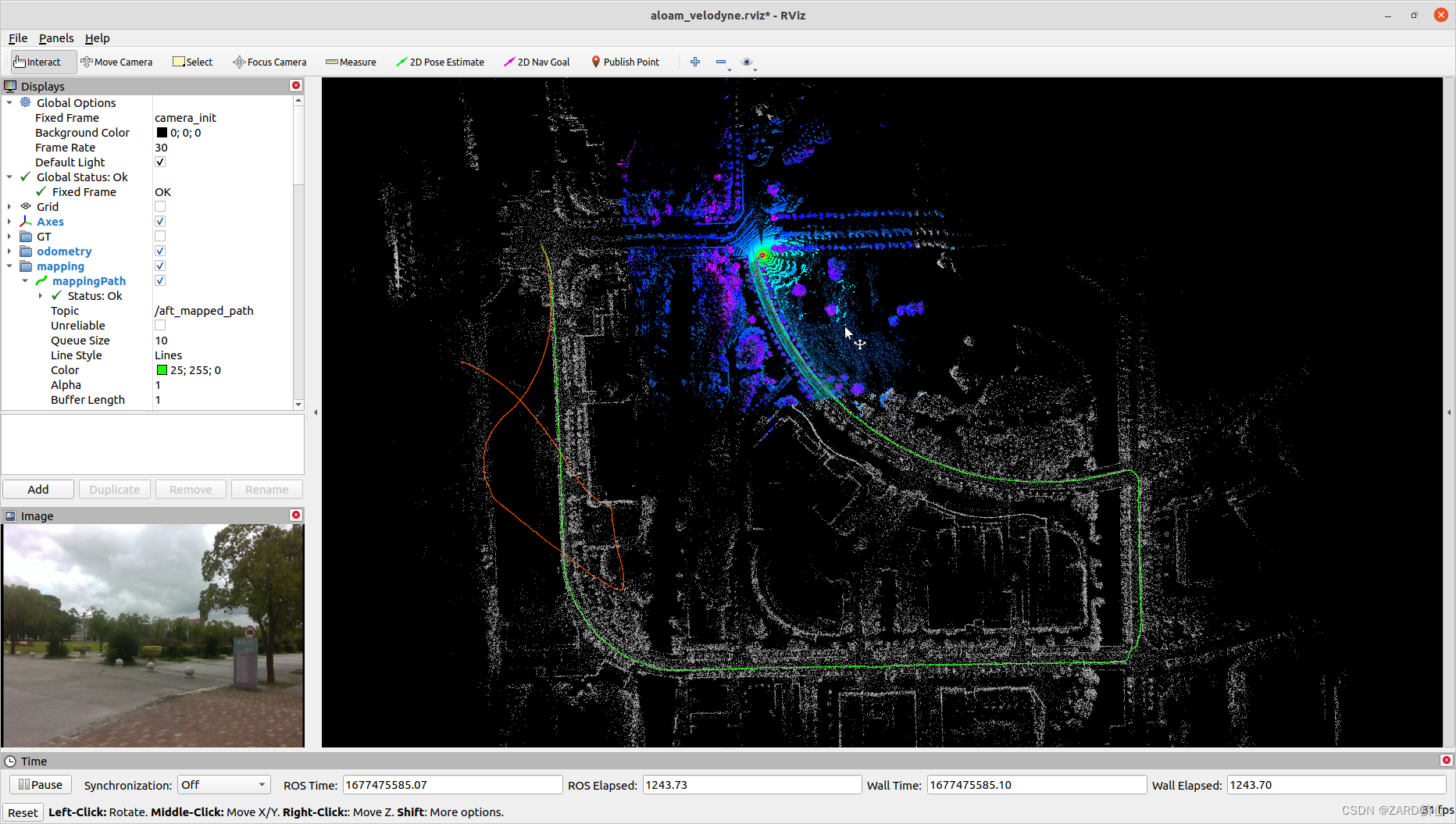
The side view shows that the front-end odometer drift is very severe, illustrating the importance of local optimization in the back-end

7, LeGO-LOAM
LeGO-LOAM is also simple to run, with LiDAR topics as/velodyne_points, IMU Topics/handsfree/imurenamed/imu/data:
source devel/setup.bash
roslaunch lego_loam run.launch
# Open a terminal in the folder where bag is located and start playing the dataset:
rosbag play street_02.bag --clock /handsfree/imu:=/imu/dataAs shown in the figure below, LeGO-LOAM has a large drift
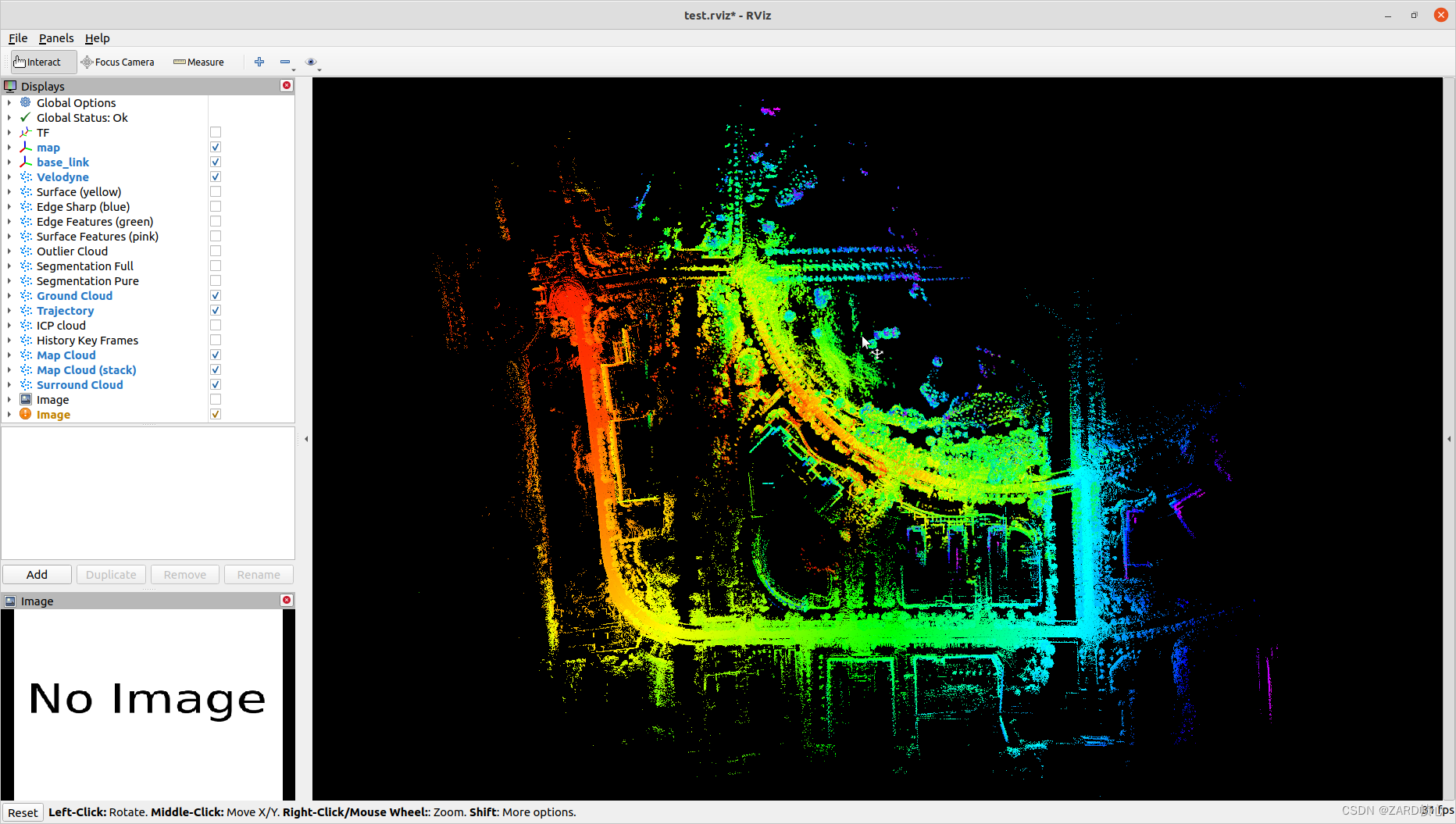
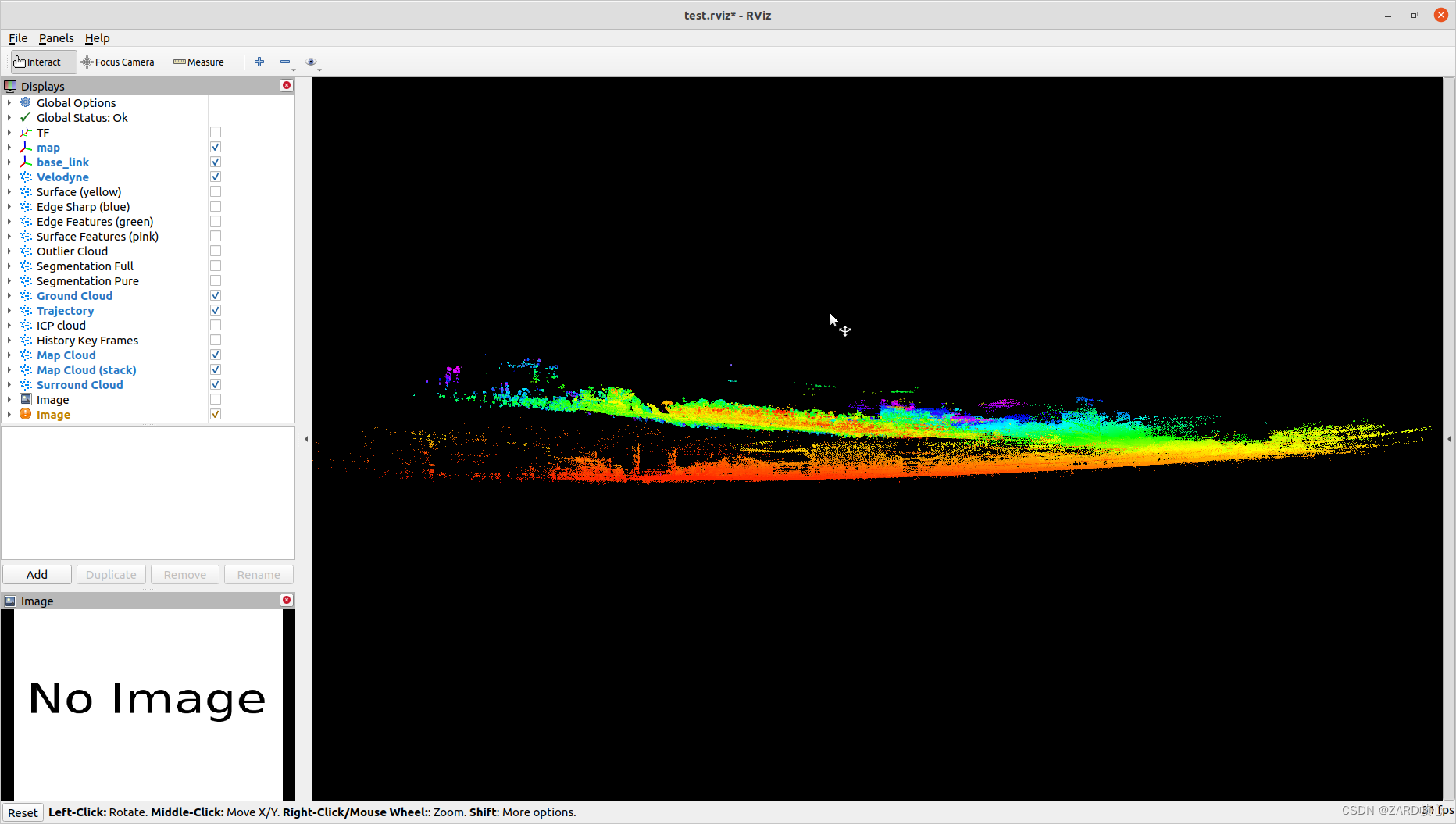
8, LIO-SAM
8.1 Configuration parameters
inconfigAdd a parameter file to the folderconfig/params_street.yamlmodeled afterconfig/params.yamlfile, rootxsens_imu_param.yamlandextrinsic.yamlFile modification parameters, mainly modify LiDAR and IMU data topics, results output path, IMU internal reference and joint calibration results, the rest of the parameters are adjusted according to need.
pointCloudTopic: "velodyne_points" # Point cloud data
imuTopic: "/handsfree/imu" # IMU data
# Export settings
savePCD: true # https://github.com/TixiaoShan/LIO-SAM/issues/3
savePCDDirectory: "~/Output/" # in your home folder, starts and ends with "/". Warning: the code deletes "LOAM" folder then recreates it. See "mapOptimization" for implementation
# Sensor Settings
sensor: velodyne # lidar sensor type, either 'velodyne' or 'ouster'
N_SCAN: 32 # number of lidar channel (i.e., 16, 32, 64, 128)
Horizon_SCAN: 1800 # lidar horizontal resolution (Velodyne:1800, Ouster:512,1024,2048)
downsampleRate: 1 # default: 1. Downsample your data if too many points. i.e., 16 = 64 / 4, 16 = 16 / 1
lidarMinRange: 1.0 # default: 1.0, minimum lidar range to be used
lidarMaxRange: 1000.0
# IMU Settings
imuAccNoise: 3.7686306102624571e-02
imuGyrNoise: 2.3417543020438883e-03
imuAccBiasN: 1.1416642385952368e-03
imuGyrBiasN: 1.4428407712885209e-05
# Shanghai is located at 31°12′ N. The exact value of the acceleration of gravity g is 9.7940 m/s².
imuGravity: 9.7940
imuRPYWeight: 0.01
# Extrinsics (lidar -> IMU)
# is given as IMU -> lidar, but the rotation matrix is a unitary matrix, so it's straightforward to take negative
extrinsicTrans: [0.27255, -0.00053, 0.17954]
extrinsicRot: [1, 0, 0,
0, 1, 0,
0, 0, 1]
extrinsicRPY: [1, 0, 0,
0, 1, 0,
0, 0, 1]inlaunch/run.launchModify the parameter text path in
<!-- <rosparam file="$(find lio_sam)/config/params.yaml" command="load" /> -->
<rosparam file="$(find lio_sam)/config/params_street.yaml" command="load" />8.2 Operation
source devel/setup.bash
roslaunch lio_sam run.launch
# Open a terminal in the folder where bag is located and start playing the dataset:
rosbag play street_02.bagFor some reason, the LIO-SAM results don’t look as good as A-LOAM, which will be analyzed later on
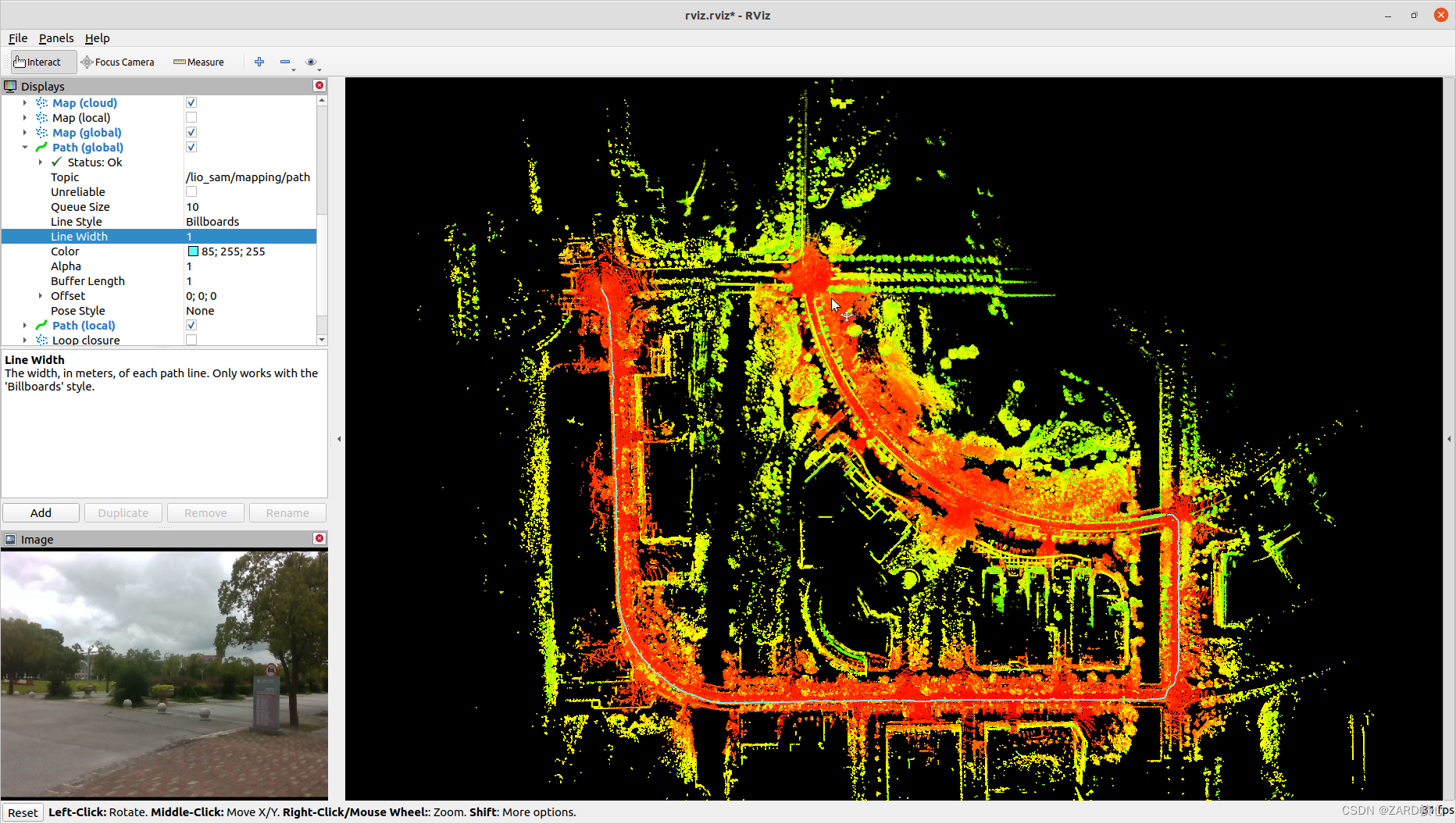

Nine, LVI-SAM
9.1 Configuration parameters
The authors of M2DGR have provided a parameter profile for LVI-SAMmodule_sam.launch、my_params_camera.yaml、my_params_lidar.yaml, the main thing to keep in mind is the following parameters:
# my_params_camera.yaml
#common parameters
imu_topic: "/handsfree/imu"
image_topic: "/camera/color/image_raw"
# lidar to camera extrinsic
lidar_to_cam_tx: 0.27255
lidar_to_cam_ty: -0.00053
lidar_to_cam_tz: 0.17954
lidar_to_cam_rx: 0.0
lidar_to_cam_ry: 0.0
lidar_to_cam_rz: 0.0
# camera model
model_type: PINHOLE
camera_name: camera
# Mono camera config
image_width: 640
image_height: 480
distortion_parameters:
k1: 0.148000794688248
k2: -0.217835187249065
p1: 0
p2: 0
projection_parameters:
fx: 617.971050917033
fy: 616.445131524790
cx: 327.710279392468
cy: 253.976983707814
#imu parameters The more accurate parameters you provide, the worse performance
acc_n: 1.2820343288774358e-01 # accelerometer measurement noise standard deviation. #0.2
gyr_n: 2.1309311394972831e-02 # gyroscope measurement noise standard deviation. #0.05
acc_w: 1.3677912958097768e-02 # accelerometer bias random work noise standard deviation. #0.02
gyr_w: 3.6603917782528627e-04 # gyroscope bias random work noise standard deviation. #4.0e-5
g_norm: 9.805 # gravity magnitude
# Extrinsic parameter between IMU and Camera.
estimate_extrinsic: 0
extrinsicRotation: !!opencv-matrix
rows: 3
cols: 3
dt: d
data: [ 0.0, 0.0, 1.0,
-1.0, 0.0, 0.0,
0.0, -1.0, 0.0]
#Translation from camera frame to imu frame, imu^T_cam
extrinsicTranslation: !!opencv-matrix
rows: 3
cols: 1
dt: d
data: [0.57711, -0.00012, 0.83333]
#feature traker paprameters
freq: 20# my_params_lidar.yaml
# Topics
pointCloudTopic: "velodyne_points" # Point cloud data
imuTopic: "handsfree/imu" # IMU data
# Heading
useImuHeadingInitialization: false # if using GPS data, set to "true"
# Export settings
savePCD: true # https://github.com/TixiaoShan/LIO-SAM/issues/3
savePCDDirectory: "~/Output/" # in your home folder, starts and ends with "/". Warning: the code deletes "LOAM" folder then recreates it. See "mapOptimization" for implementation
# Sensor Settings
N_SCAN: 32 # number of lidar channel (i.e., 16, 32, 64, 128)
Horizon_SCAN: 1800 # lidar horizontal resolution (Velodyne:1800, Ouster:512,1024,2048)
timeField: "time" # point timestamp field, Velodyne - "time", Ouster - "t"
downsampleRate: 1 # default: 1. Downsample your data if too many points. i.e., 16 = 64 / 4, 16 = 16 / 1
# IMU Settings
imuAccNoise: 3.7686306102624571e-02
imuGyrNoise: 2.3417543020438883e-03
imuAccBiasN: 1.1416642385952368e-03
imuGyrBiasN: 1.4428407712885209e-05
imuGravity: 9.805
# Extrinsics (lidar -> IMU)
extrinsicTrans: [0.27255, -0.00053,0.17954]
extrinsicRot: [1, 0, 0, 0, 1, 0, 0, 0, 1]
extrinsicRPY: [1, 0, 0, 0, 1, 0, 0, 0, 1]<! -- Image decompression -->
<node pkg="image_transport" type="republish" name="image_republish" args="compressed in:=/camera/color/image_raw raw out:=/camera/color/image_raw" output="screen" respawn="true"/>
<!-- Lidar odometry param -->
<rosparam file="$(find lvi_sam)/config/my_params_lidar.yaml" command="load" />
<!-- VINS config -->
<param name="vins_config_file" type="string" value="$(find lvi_sam)/config/my_params_camera.yaml" />9.2 Operation
Since M2DGR uses a different sensor coordinate system than the LVI-SAM data (actually the LVI-SAM IMU is more specific), which is also provided by the M2DGR authors, a slight modification is needed in the internal code, which is modified as follows:
- src/visual_odometry/visual_estimator/initial/initial_alignment.h
// n(n_in)
// {
// q_lidar_to_cam = tf::Quaternion(0, 1, 0, 0);
// q_lidar_to_cam_eigen = Eigen::Quaterniond(0, 0, 0, 1);
// }
n(n_in)
{
q_lidar_to_cam = tf::Quaternion(0, 0, 0, 1);
q_lidar_to_cam_eigen = Eigen::Quaterniond(1,0,0,0);
}// tf::Quaternion q_odom_cam = tf::createQuaternionFromRPY(0, 0, M_PI) * (q_odom_lidar * q_lidar_to_cam);
tf::Quaternion q_odom_cam = tf::createQuaternionFromRPY(0, 0, M_PI / 2.0) * (q_odom_lidar * q_lidar_to_cam);- src/visual_odometry/visual_estimator/utility/visualization.cpp
// tf::Quaternion q_cam_to_lidar(0, 1, 0, 0);
tf::Quaternion q_cam_to_lidar(0, 0, 0, 1);
// static tf::Transform t_odom_world = tf::Transform(tf::createQuaternionFromRPY(0, 0, M_PI), tf::Vector3(0, 0, 0));
static tf::Transform t_odom_world = tf::Transform(tf::createQuaternionFromRPY(0, 0, 0), tf::Vector3(0, 0, 0));- src/visual_odometry/visual_feature/feature_tracker_node.cpp**
// Comment the following code:
// pcl::PointCloud<PointType>::Ptr laser_cloud_offset(new pcl::PointCloud<PointType>());
// Eigen::Affine3f transOffset = pcl::getTransformation(L_C_TX, L_C_TY, L_C_TZ, L_C_RX, L_C_RY, L_C_RZ);
// pcl::transformPointCloud(*laser_cloud_in, *laser_cloud_offset, transOffset);
// *laser_cloud_in = *laser_cloud_offset;Recompile after modification:
cd ~/catkin_ws
catkin_make -j1(of a computer) run
source devel/setup.bash
roslaunch lvi_sam run.launch
# Open a terminal in the folder where bag is located and start playing the dataset:
rosbag play street_02.bagAs with LIO-SAM, it doesn’t work as well and looks even worse than LIO-SAM
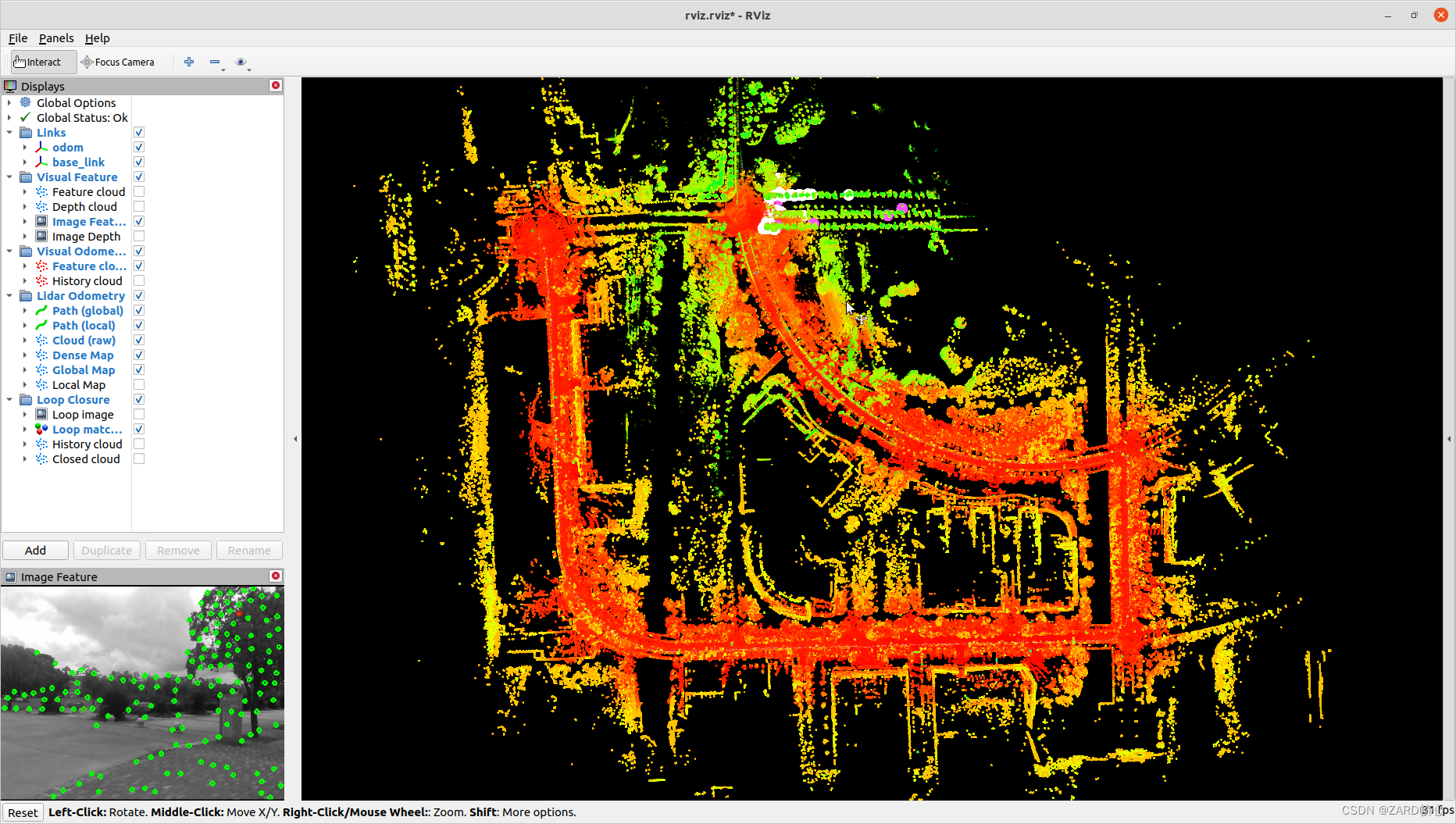
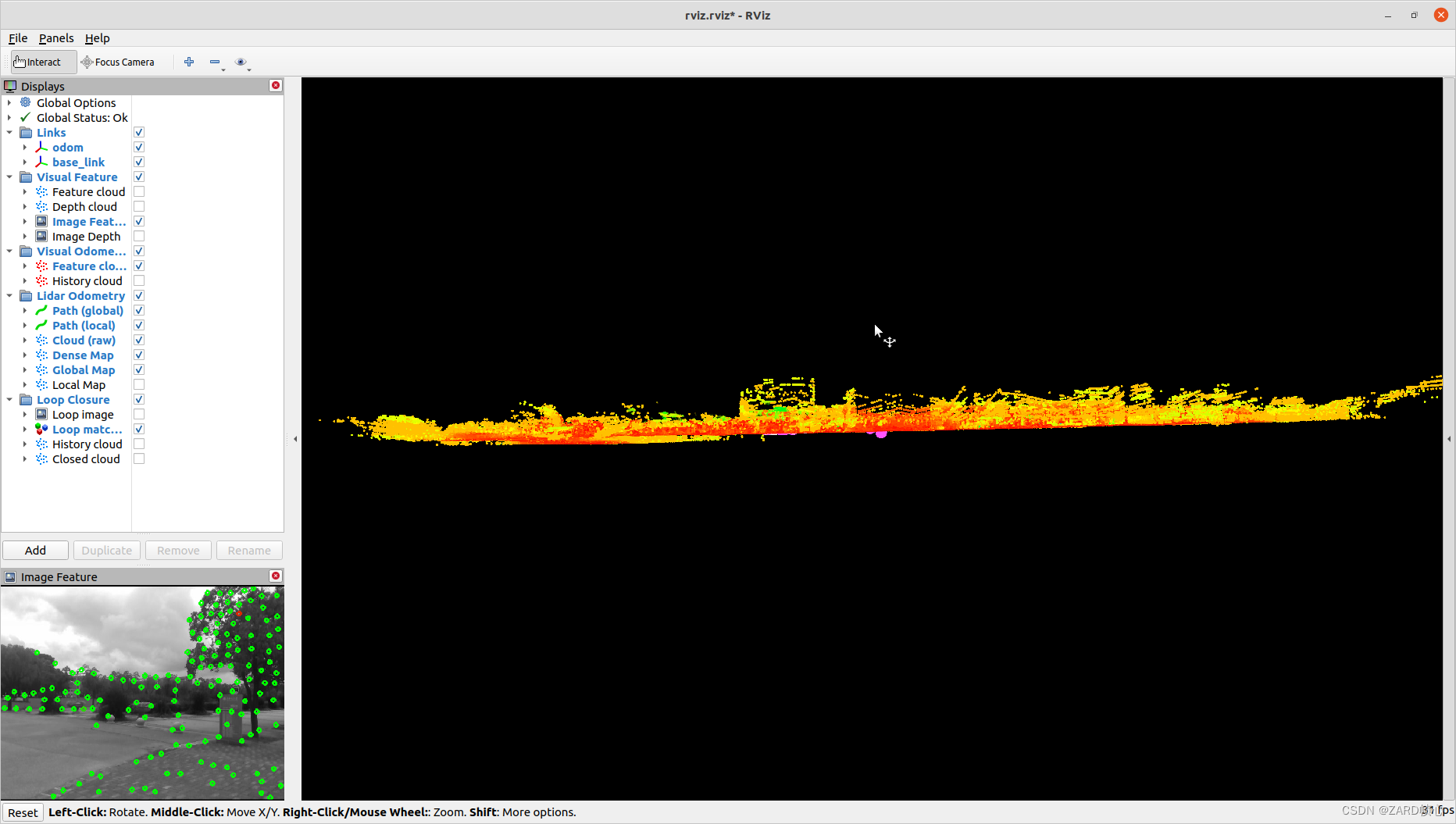
10, LINS
10.1 Installation
With ROS, gtsam and OpenCV already installed:
cd ~/catkin_ws/src
git clone https://github.com/ChaoqinRobotics/LINS---LiDAR-inertial-SLAM.git
cd ..
catkin_make -j1Note that as with LeGO-LOAM, the first time you compile the code, you need to add the “catkin_make“-j1” is added to generate some message types. Subsequent compilations do not require “-j1”, and message names will conflict if placed in a function package with LeGO-LOAM (optionally, the message name can be changed, or the function package for which one of the messages was compiled can be deleted).
- Changed C++ standard to 14 due to PCL version 1.10:
#set(CMAKE_CXX_FLAGS "${CMAKE_CXX_FLAGS} -std=c++11 -O3")
set(CMAKE_CXX_FLAGS "${CMAKE_CXX_FLAGS} -std=c++14 -O3")- Encountering errors:
error: ‘string’ in namespace ‘std::__cxx11’ does not name a typewilllins/src/lib/parameters.cppin the function arguments in lines 134 and 141 of thestd::__cxx11::stringadapt (a story to another medium)std::string - Four similar mistakes:
/usr/bin/ld: cannot find -lBoost::serialization, couldn’t find four libraries for lBoost.CMakeLists.txtAdd:
find_package(Boost REQUIRED COMPONENTS timer thread serialization chrono)10.2 Configuration parameters
acc_n: 3.7686306102624571e-02
gyr_n: 2.3417543020438883e-03
acc_w: 1.1416642385952368e-03
gyr_w: 1.4428407712885209e-05
# extrinsic parameters
init_tbl: !!opencv-matrix
rows: 3
cols: 1
dt: d
data: [0.27255, -0.00053,0.17954]
init_rbl: !!opencv-matrix
rows: 3
cols: 3
dt: d
data: [1, 0, 0,
0, 1, 0,
0, 0, 1]<arg name="config_path" default = "$(find lins)/config/exp_config/M2DGR.yaml" />10.3 Operation
source devel/setup.bash
roslaunch lins run_M2DGR.launch
# Open a terminal in the folder where bag is located and start playing the dataset:
rosbag play street_02.bag --clock /handsfree/imu:=/imu/dataRuntime error:[ERROR] [1677898050.385013867, 1627957054.444385592]: Error transforming odometry 'Odometry' from frame '/camera_init' to frame 'map'inlidar_mapping_node.cpp、transform_fusion_node.cpp、Estimator.cppThe code searches for all/camera_initadapt (a story to another medium)camera_init
Larger drift in the vertical direction
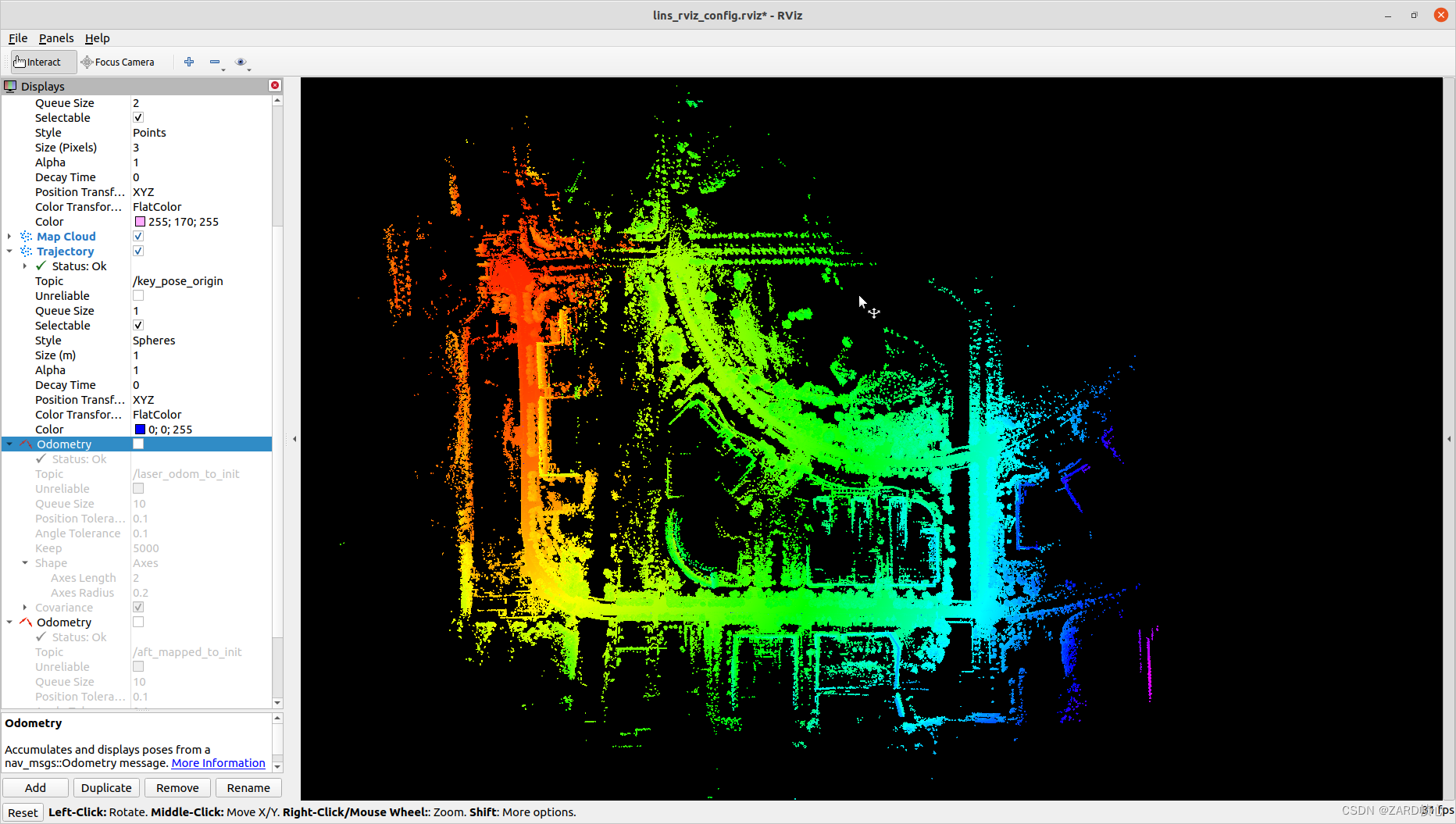
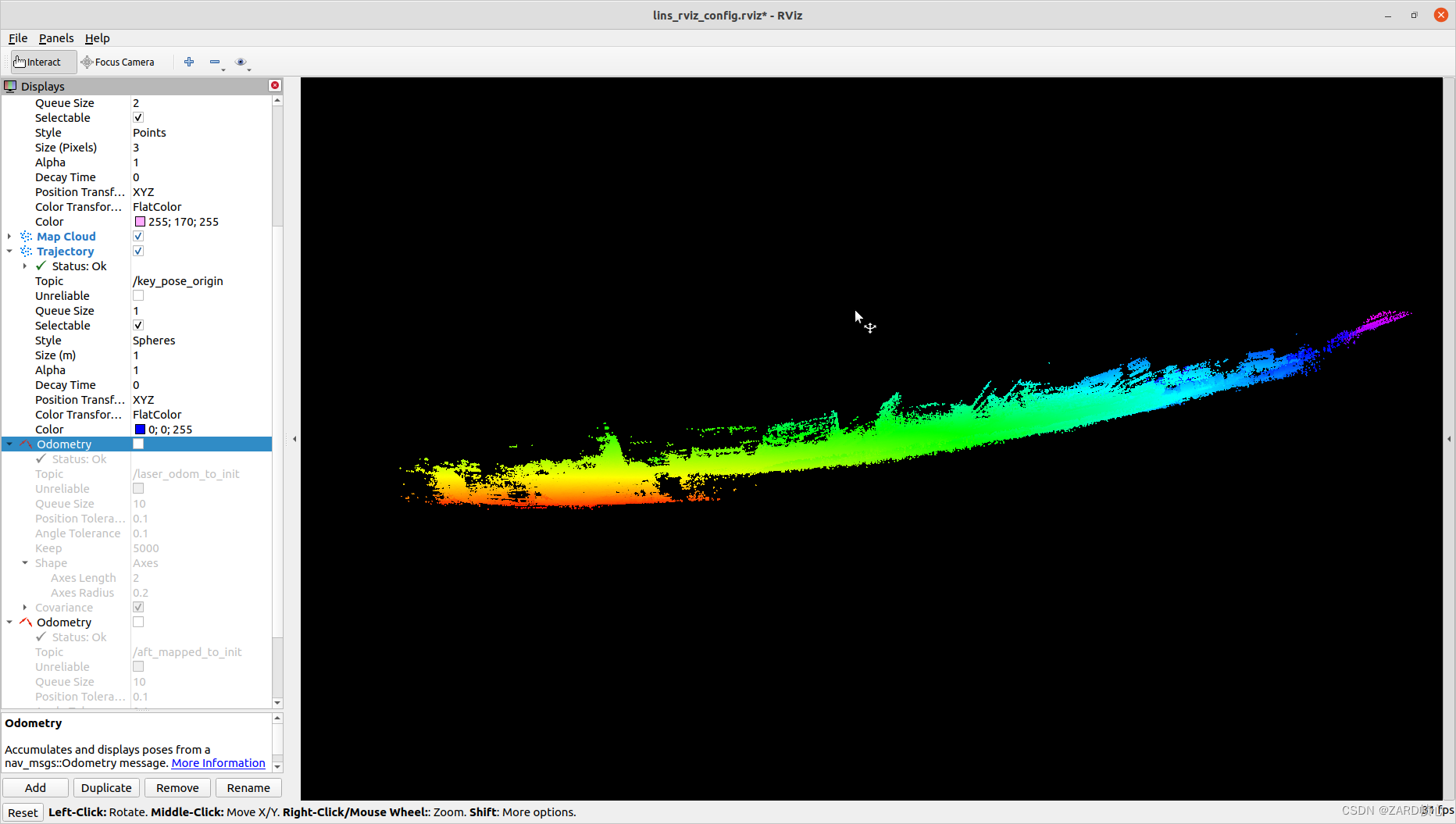
XI. FAST-LIO2
FAST-LIOis a highly efficient LiDAR inertial odometry framework from the Mars Lab at the University of Hong Kong that uses a tightly coupled iteratively extended Kalman filter to fuse LiDAR feature points with IMU data to allow robust navigation in fast-moving, noisy or cluttered environments where degradation occurs. Compared to the first generation version, the second generation uses ikd-Tree incremental mapping to achieve support for LiDAR rates in excess of 100 Hz and support for a wider range of LiDAR and device
11.1 Installation
Without modifying the source code, first install the dependencies:
- ROS (melodic or noetic), refer to my previous blog for installation instructions
- glog:
sudo apt-get install libgoogle-glog-dev - eigen:
sudo apt-get install libeigen3-dev - pcl:
sudo apt-get install libpcl-dev - yaml-cpp:
sudo apt-get install libyaml-cpp-dev
(1) Livox-sdk Installation
git clone https://github.com/Livox-SDK/Livox-SDK.git
cd Livox-SDK
cd build && cmake ..
make
sudo make install(2) Livox_ros_driver installation
# Open a terminal and execute the following
mkdir ws_livox/src -p
# Open the configuration file
gedit ~/.bashrc
# Add the following to the end of the document
source ~/ws_livox/devel/setup.bash
# clone livox_ros_driver to ws_livox/src
cd ~/ws_livox/src
git clone https://github.com/Livox-SDK/livox_ros_driver.git
cd ..
catkin_make
source devel/setup.sh(3) FAST_LIO Installation
cd ~/ws_livox/src
git clone https://github.com/hku-mars/FAST_LIO.git
cd ..
catkin_make11.2 Configuration parameters
Id:
common:
lid_topic: "/velodyne_points"
imu_topic: "/handsfree/imu"
preprocess:
lidar_type: 2 # 1 for Livox serials LiDAR, 2 for Velodyne LiDAR, 3 for ouster LiDAR,
scan_line: 32
scan_rate: 10 # only need to be set for velodyne, unit: Hz,
timestamp_unit: 2 # the unit of time/t field in the PointCloud2 rostopic: 0-second, 1-milisecond, 2-microsecond, 3-nanosecond.
blind: 2
mapping:
acc_cov: 3.7686306102624571e-02
gyr_cov: 2.3417543020438883e-03
b_acc_cov: 1.1416642385952368e-03
b_gyr_cov: 1.4428407712885209e-05
extrinsic_est_en: false # true: enable the online estimation of IMU-LiDAR extrinsic,
extrinsic_T: [ 0.27255, -0.00053,0.17954]
extrinsic_R: [ 1, 0, 0,
0, 1, 0,
0, 0, 1]
publish:
# Publishing path
path_en: true
pcd_save:
# Don't save cloud maps if you don't have to, they're too big #
pcd_save_en: false<rosparam command="load" file="$(find fast_lio)/config/velodyne_M2DGR.yaml" />11.3 Operation
source devel/setup.bash
roslaunch fast_lio mapping_velodyne_M2DGR.launch
# Open a terminal in the folder where bag is located and start playing the dataset:
rosbag play street_02.bagIt looks okay.
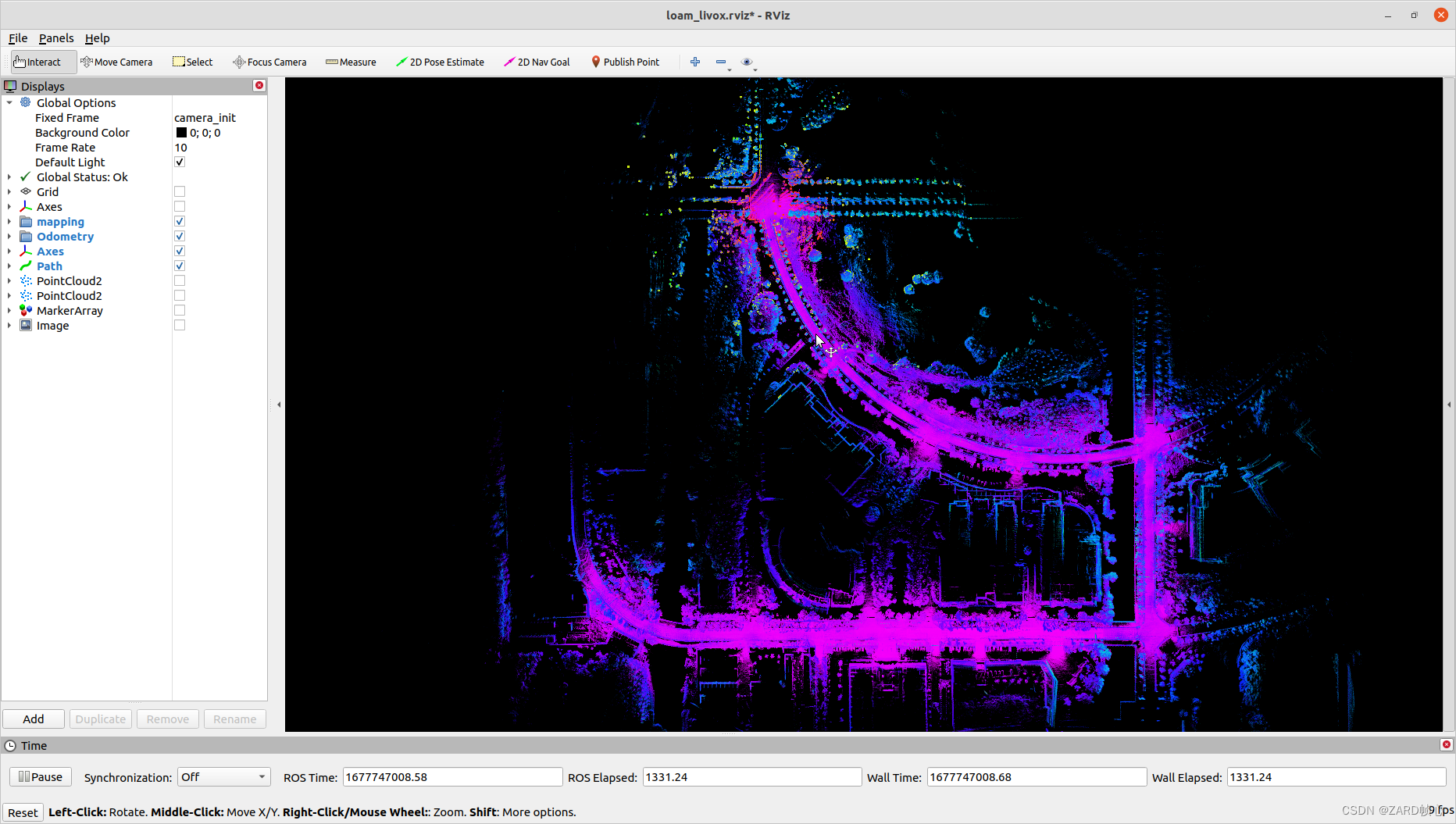
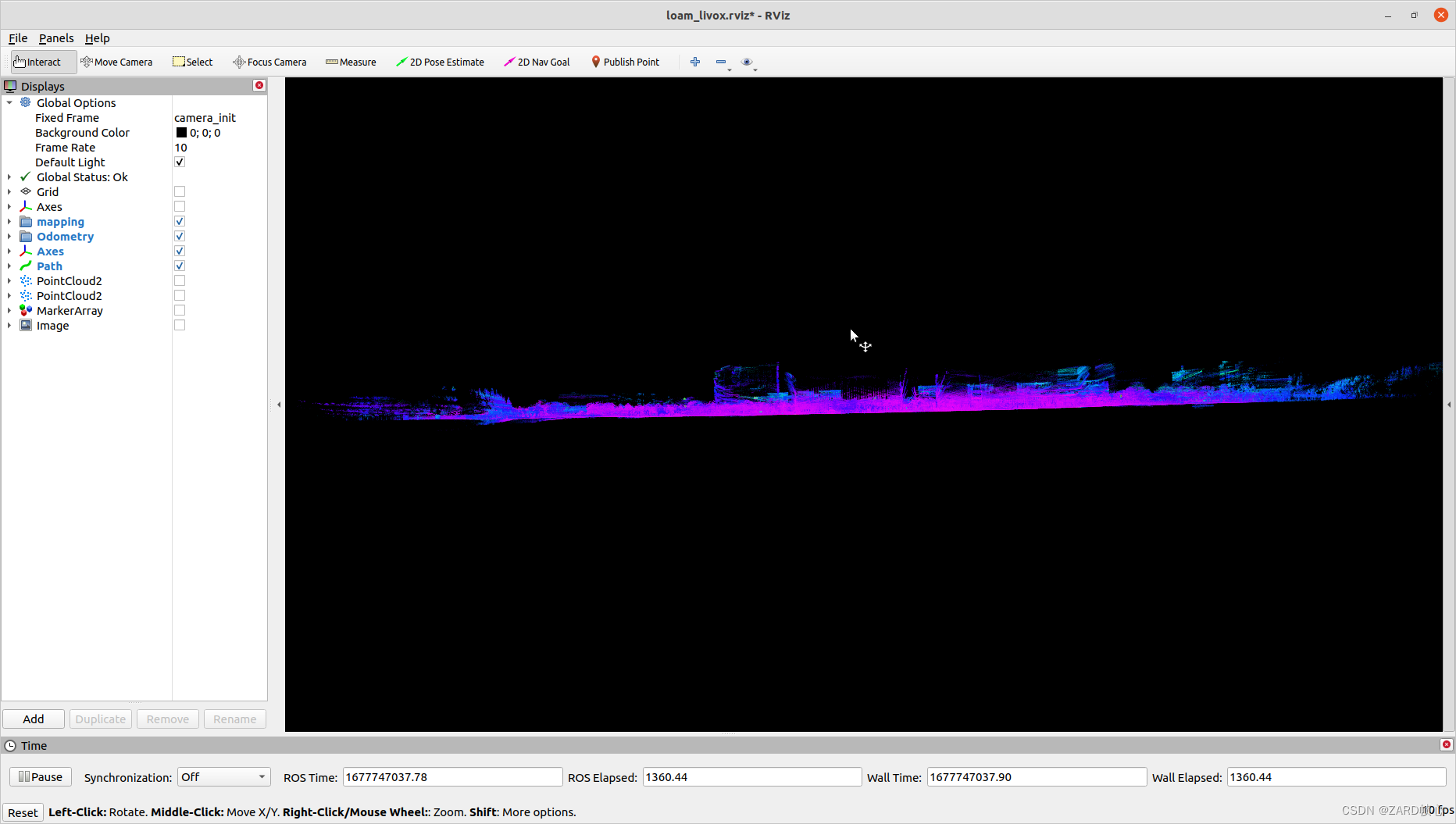
(xii) FAST-LIVO
12.1 Installation
(1) Installed:
- Ubuntu 16.04~20.04. ROS Installation.
- PCL>=1.6, Follow PCL Installation.
- Eigen>=3.3.4, Follow Eigen Installation.
- OpenCV>=3.2, Follow Opencv Installation.
- Livox-sdk
- Livox_ros_driver
(2) Install the non-template Sophus:
git clone https://github.com/strasdat/Sophus.git
cd Sophus
# version back
git checkout a621ff
mkdir build && cd build
cmake ..
makeBefore making, modify the bugs in this version of Sophus, open the Sophus/sophus/so2.cpp file, and modify the code as follows
// unit_complex_.real() = 1.;
// unit_complex_.imag() = 0.;
unit_complex_.real(1.);
unit_complex_.imag(0.);make
# If you have already installed the template class do not worry, the installation does not affect each other, *.h and *.hpp can coexist in a folder
sudo make install(3) Install Vikit
cd ~/catkin_ws/src
git clone https://github.com/uzh-rpg/rpg_vikit.git(4) Installation of FAST-LIVO
cd ~/catkin_ws/src
git clone https://github.com/hku-mars/FAST-LIVO
cd ..
catkin_makeIf the OpenCV error is reported, change the CMakeLists.txt
FIND_PACKAGE(OpenCV REQUIRED)
# Change to
FIND_PACKAGE(OpenCV 4 REQUIRED)Replace the parameter that reported the error
// CV_RANSAC
cv::RANSAC
// CV_INTER_LINEAR // Bilinear interpolation
cv::INTER_LINEAR
// CV_WINDOW_AUTOSIZE
cv::WINDOW_AUTOSIZEIf a large number of similar errors occur:/usr/bin/ld: /home/zard/catkin_ws_LiDAR/devel/lib/libvikit_common.so: undefined reference to Sophus::SE3::operator*(Eigen::Matrix<double, 3, 1, 0, 3, 1> const&) constIf you are running FIND_PACKAGE(sophus REQUIRED), libSophus.so should be linked to Sophus_LIBRARIES, but cmake is not (for unknown reasons), hence this error. Explicitly link Sophus_LIBRARIES to libSophus.so:
FIND_PACKAGE(Sophus REQUIRED)
set(Sophus_LIBRARIES libSophus.so)12.2 Operation
Write here found that due to FAST-LIVO need strict time synchronization, M2DGR data is not very good, but write and do not delete, here to run the sample data:
roslaunch fast_livo mapping_avia.launch
rosbag play hk1.bagThe figure is very beautifully built and stable
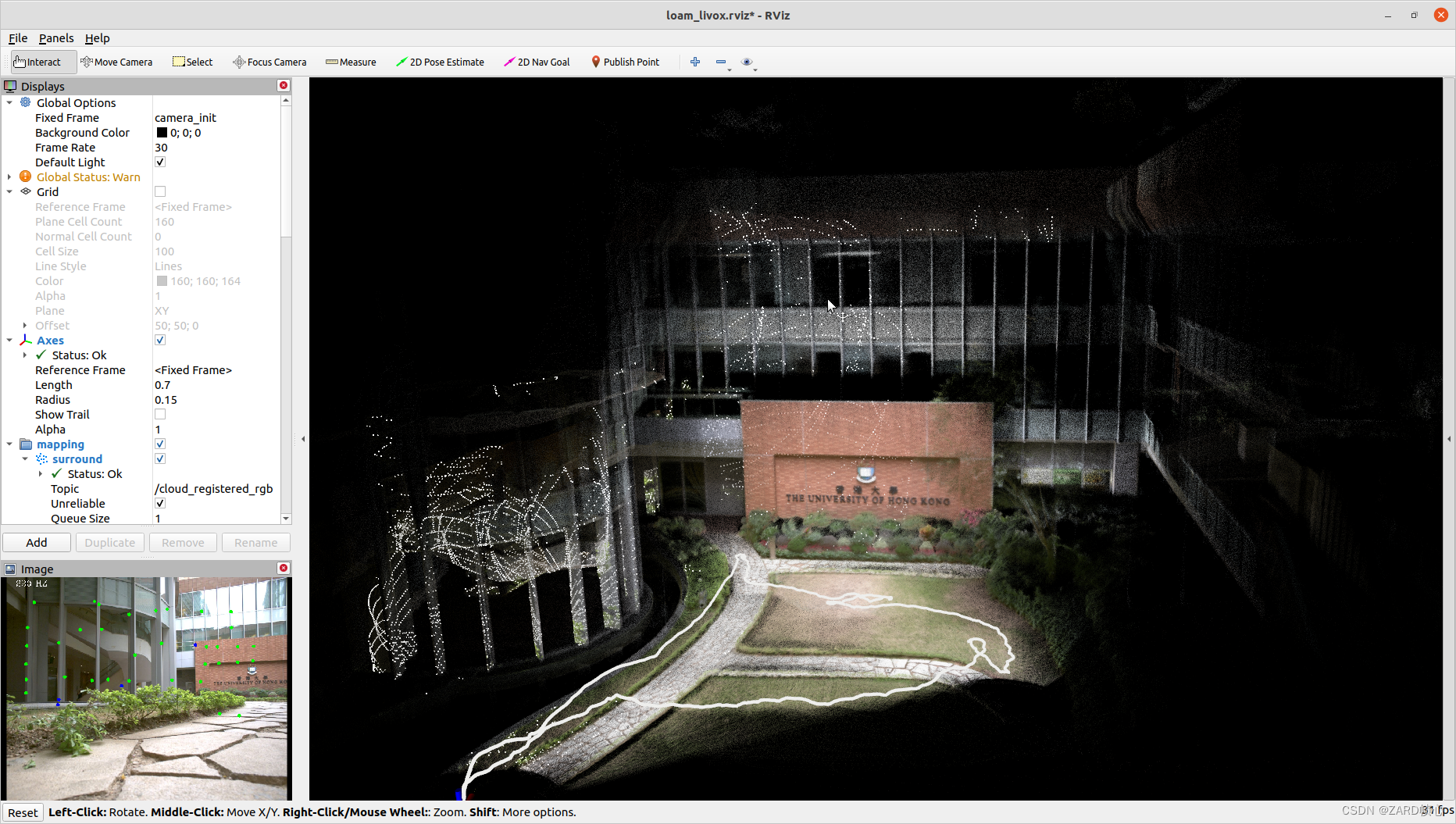
12.3 R3LIVE
Here I’ll add something similar, R3LIVE compiled and running with Livox-sdk, Livox_ros_driver already installed
(1)CGAL
sudo apt-get install libcgal-dev(2) Compilation
cd ~/catkin_ws/src
git clone https://github.com/hku-mars/r3live.git
catkin_make
source ~/catkin_ws/devel/setup.bash(3) Running
roslaunch r3live r3live_bag.launch
rosbag play YOUR.bag

Thirteen, Faster-LIO
Faster_LIOIt is an open source SLAM improved by Gobo on FAST_LIO, which makes SLAM more efficient.
13.1 Faster-LIO Installation
The compilation of Faster-LIO is very simple, Gobo has already tested it in 20.04, first install the dependencies:
- ROS (melodic or noetic), refer to my previous blog for installation instructions
- glog:
sudo apt-get install libgoogle-glog-dev - eigen:
sudo apt-get install libeigen3-dev - pcl:
sudo apt-get install libpcl-dev - yaml-cpp:
sudo apt-get install libyaml-cpp-dev
It can be compiled afterwards:
# Be careful not to be in the same workspace as Livox_ros_driver, otherwise Livox_ros_driver node name conflict
mkdir catkin_ws/src -p
cd catkin_ws
catkin_make13.2 Configuration parameters
Add the configuration file and the launch file, modifying the following
common:
dataset: "M2DGR"
lid_topic: "velodyne_points"
imu_topic: "handsfree/imu"
time_sync_en: false # ONLY turn on when external time synchronization is really not possible
preprocess:
lidar_type: 2 # 1 for Livox serials LiDAR, 2 for Velodyne LiDAR, 3 for ouster LiDAR,
scan_line: 32
blind: 4
time_scale: 1e3 # Compatible with different dataset time units
mapping:
acc_cov: 3.7686306102624571e-02
gyr_cov: 2.3417543020438883e-03
b_acc_cov: 1.1416642385952368e-03
b_gyr_cov: 1.4428407712885209e-05
fov_degree: 180
det_range: 100.0
extrinsic_est_en: true # true: enable the online estimation of IMU-LiDAR extrinsic
extrinsic_T: [ 0.27255, -0.00053,0.17954]
extrinsic_R: [ 1, 0, 0,
0, 1, 0,
0, 0, 1]<!-- Launch file for velodyne32 VLP-32 LiDAR -->
<rosparam command="load" file="$(find faster_lio)/config/velodyne_M2DGR.yaml" />13.3 Operation
source devel/setup.bash
roslaunch faster_lio mapping_velodyne_M2DGR.launch
# Open a terminal in the folder where bag is located and start playing the dataset:
rosbag play street_02.bagThe Faster-Lio effect looks surprisingly good visually, with beautiful details in the built-up diagrams. Specific accuracy depends on the back of the comparison, but the running efficiency of the pro-measurement is indeed much higher than FAST-LIO!
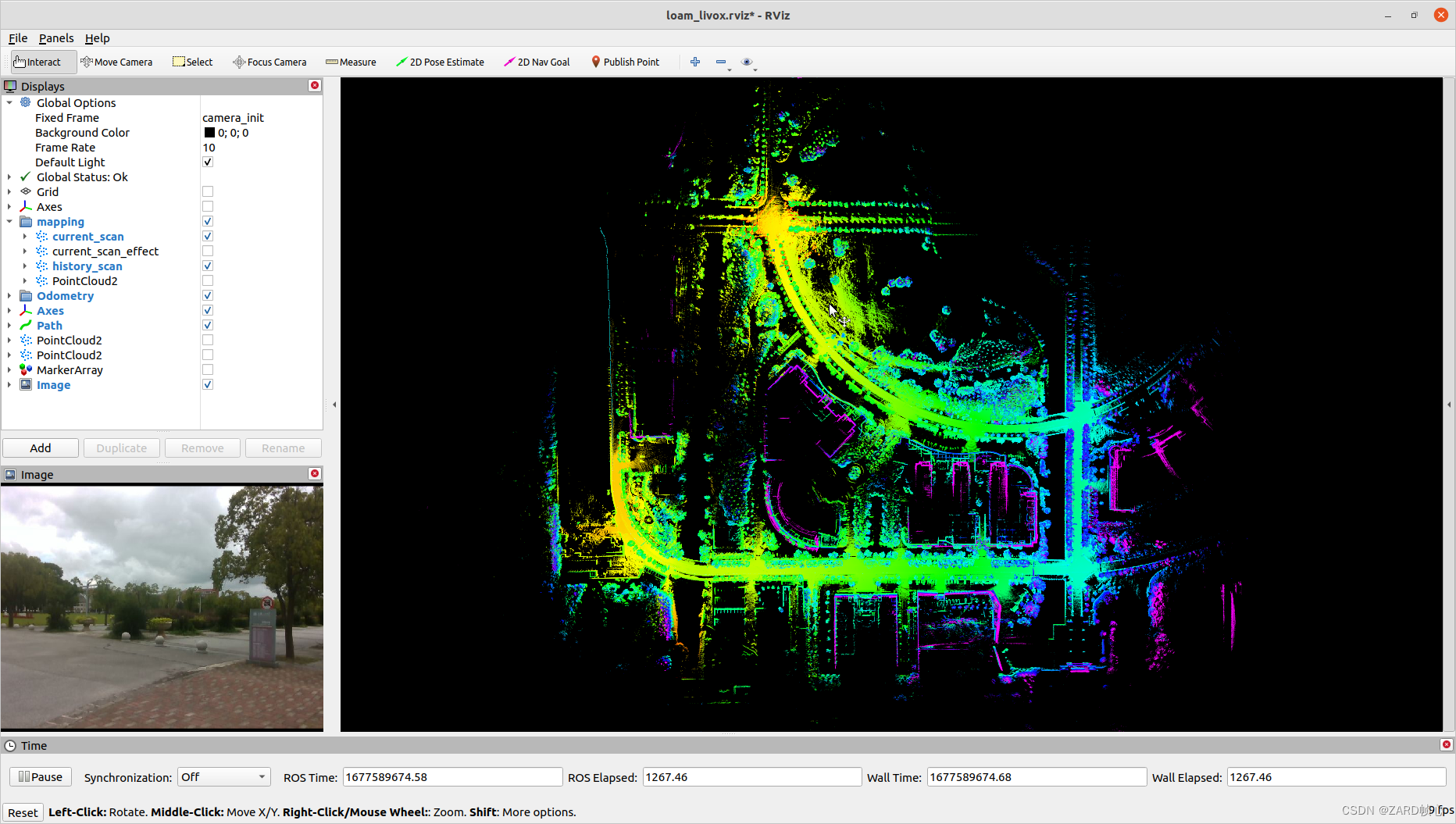
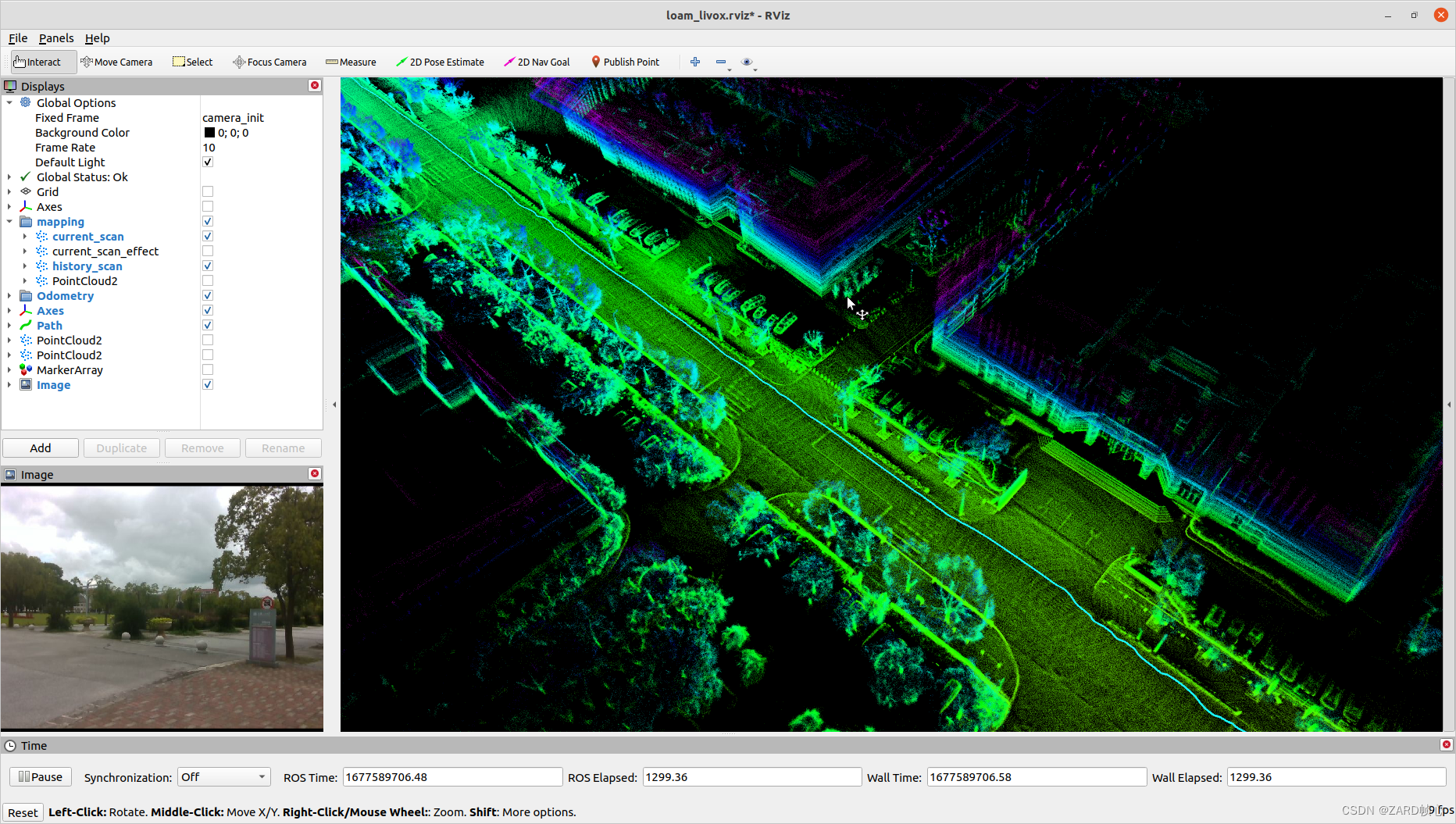
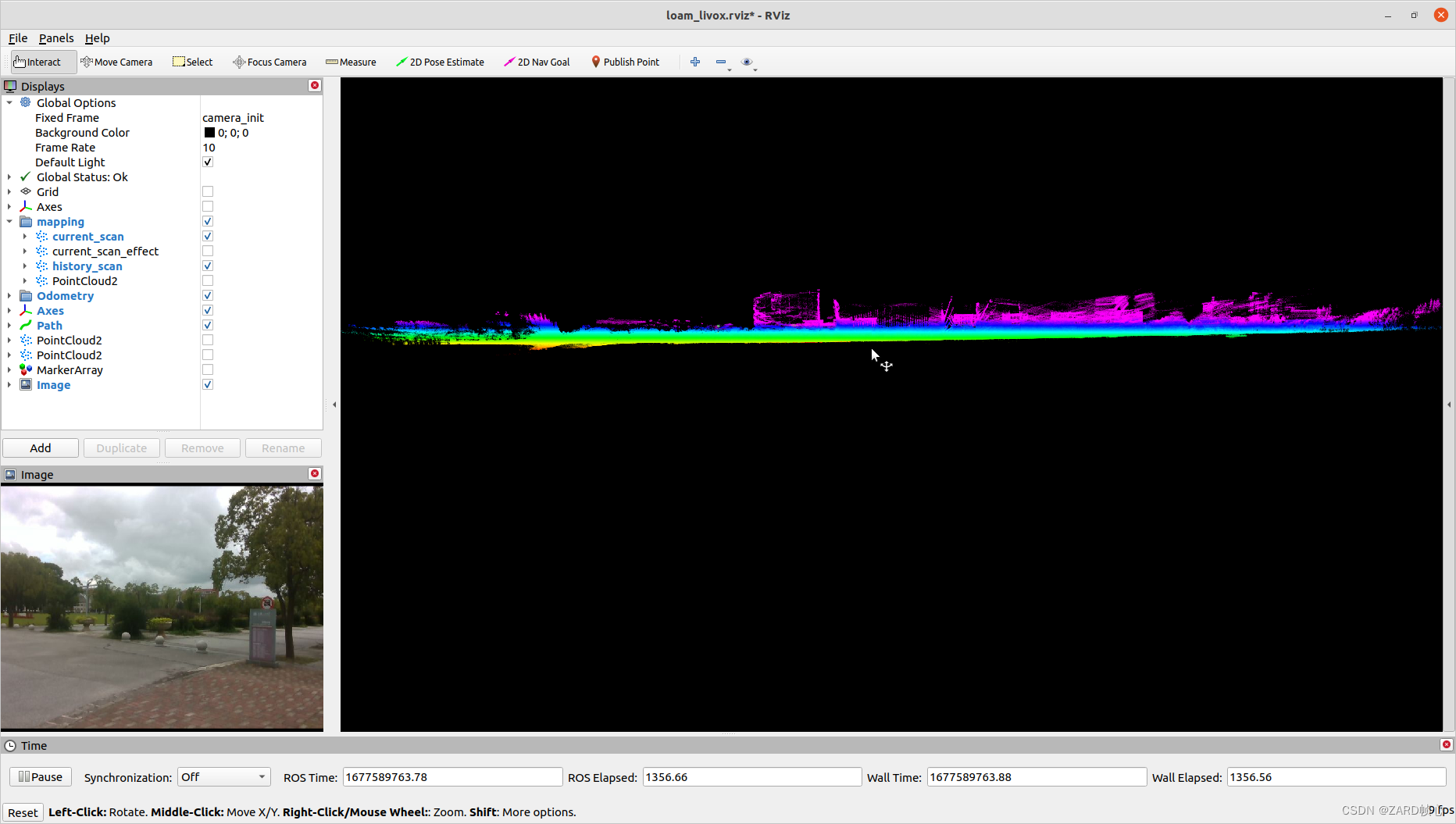
xiv. hdl_graph_slam
hdl-graph-slam not only integrates multiple inputs such as imu, gps, planar, laser, etc., but also carries back-end processing such as closed-loop detection, i.e., a complete one-slam architecture.
14.1 Installation
First we installed ROS and then
sudo apt-get install ros-noetic-geodesy ros-noetic-pcl-ros ros-noetic-nmea-msgs ros-noetic-libg2o
cd catkin_ws/src
git clone https://github.com/koide3/ndt_omp.git
git clone https://github.com/SMRT-AIST/fast_gicp.git --recursive
git clone https://github.com/koide3/hdl_graph_slam
cd .. && catkin_make -DCMAKE_BUILD_TYPE=Release14.2 Pure laser
Open four terminals, each
# Start the master node
roscore
# Set the use_sim_time parameter and run
rosparam set use_sim_time true
roslaunch hdl_graph_slam hdl_graph_slam_400.launch
# Start rviz visualization
roscd hdl_graph_slam/rviz
rviz -d hdl_graph_slam.rviz
# Open a terminal in the folder where bag is located and start playing the dataset:
rosbag play street_02.bag --clock
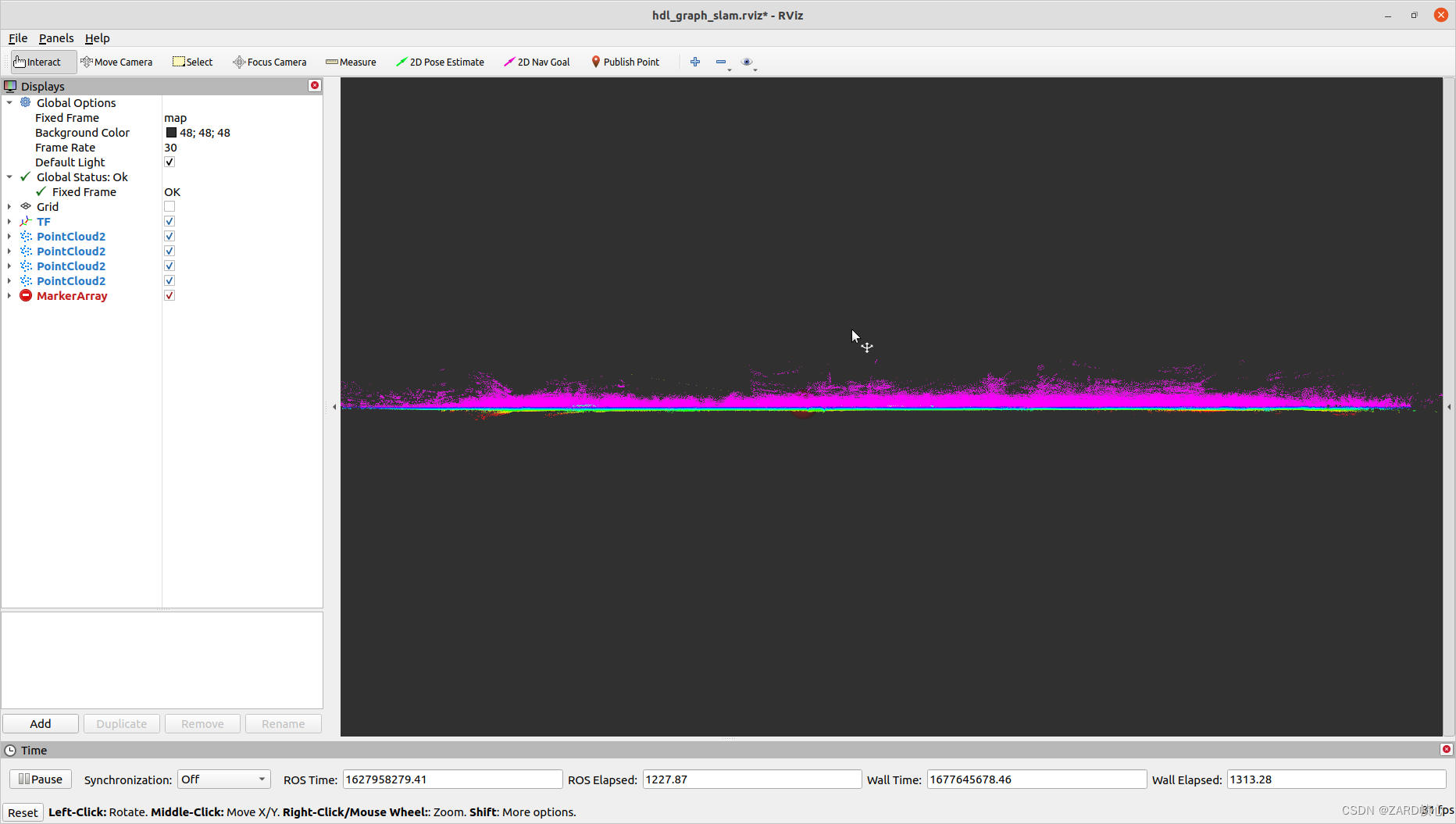
XV. Quality assessment and comparison of positioning results
As for the saving of trajectories, I have added the code for saving TUM format bit poses in the build module, so I won’t write about it in detail here.
First find the absolute error of each trajectory (A-LOAM for example, thestreet_02.txt(is the trajectory truth value and A-LOAM is the A-LOAM trajectory output):
evo_ape tum street_02.txt A-LOAM -va -s --plot --plot_mode=xy --save_results A-LOAM.zip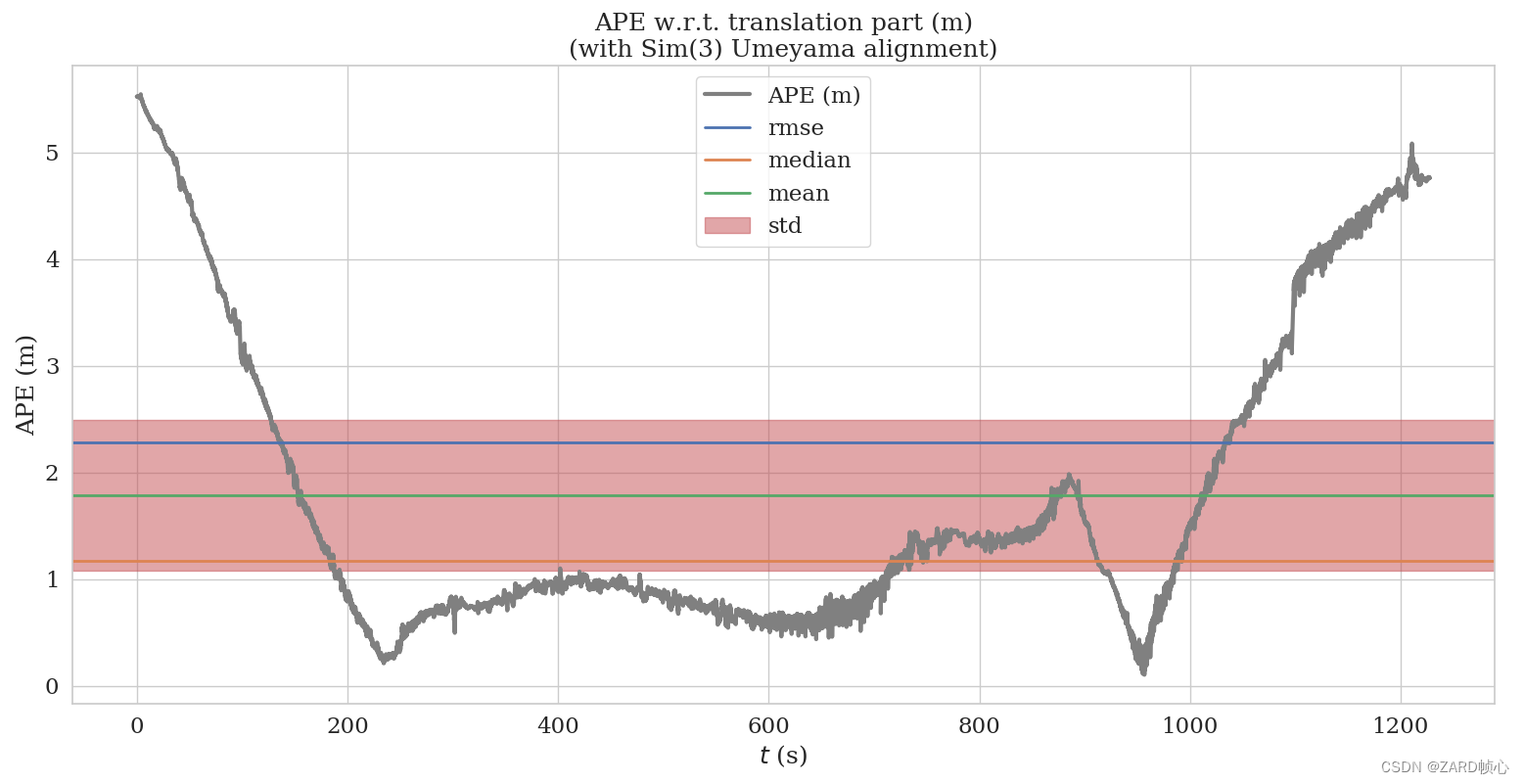

The same method was used to obtain the absolute trajectory error results for the other trajectories, which were placed in the same folder and compared:
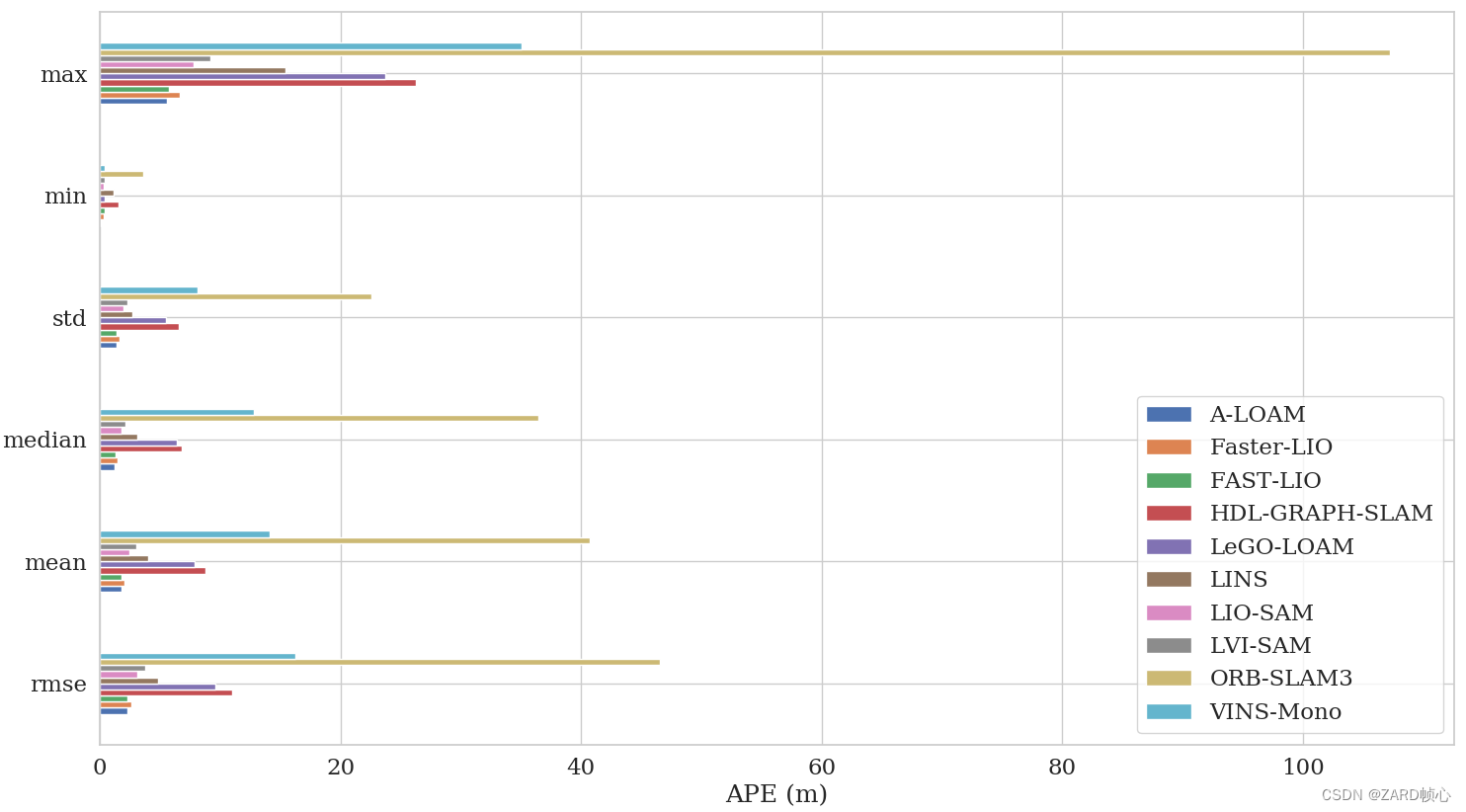
You can see that the error of ORB-SLAM3 is too large, and we remove it to compare other
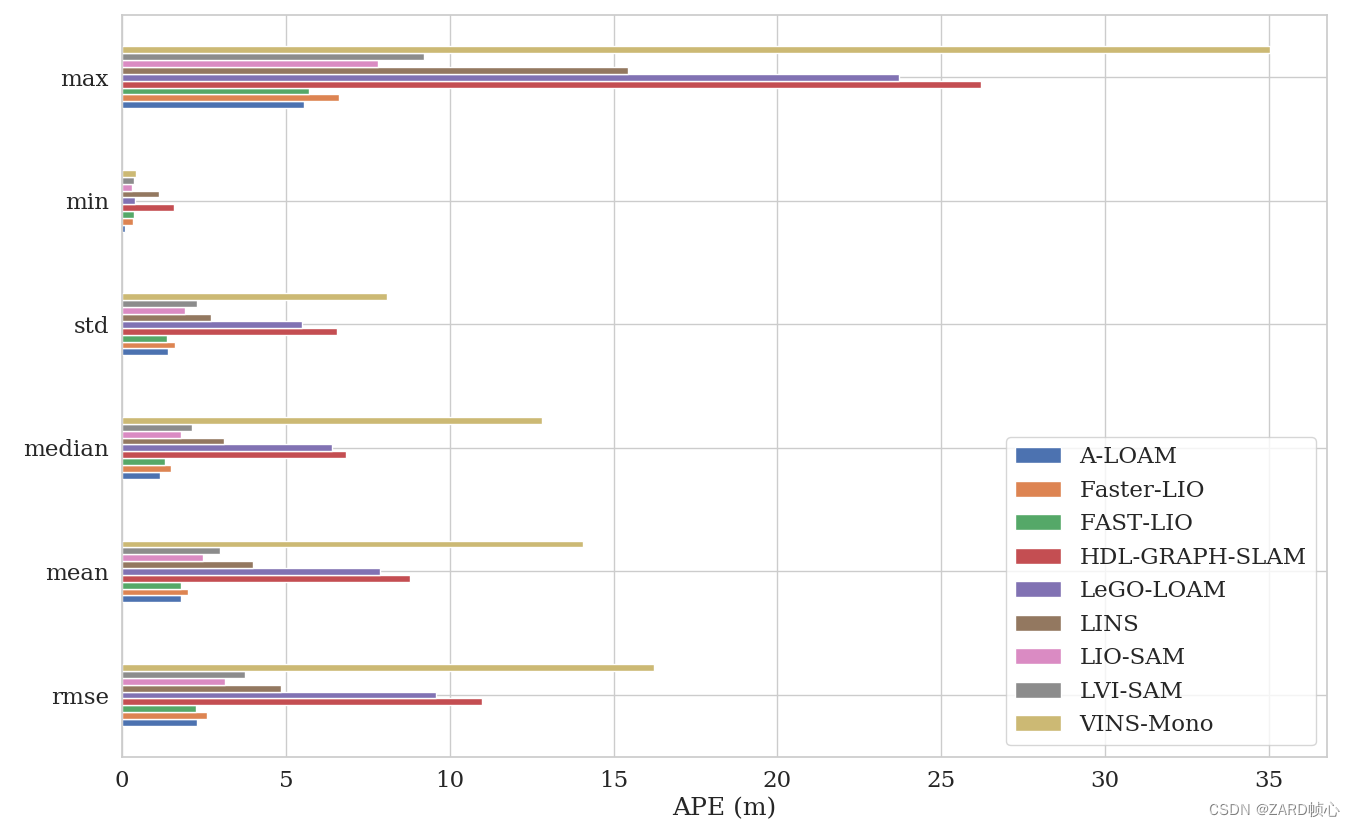
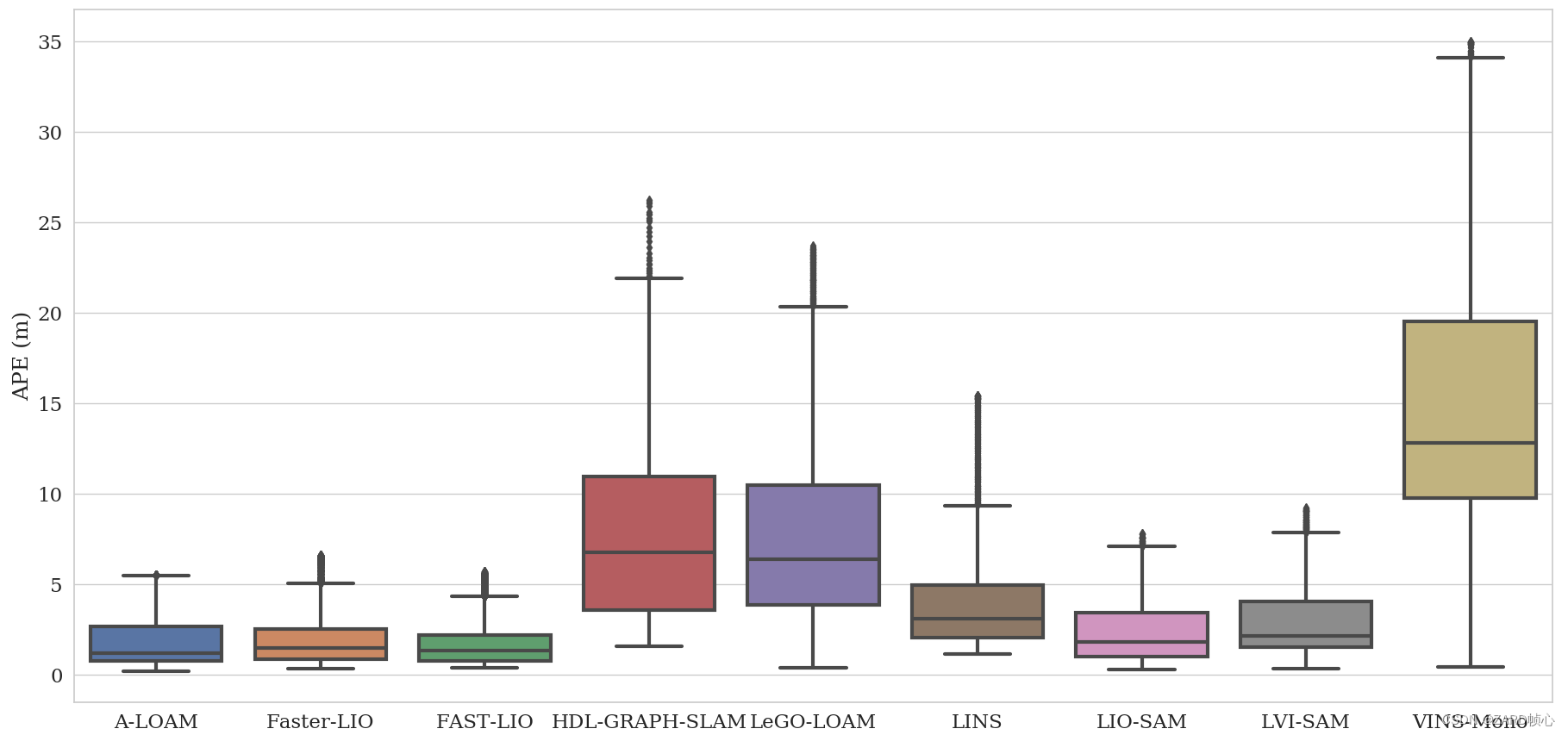
For this data, the visual results are not so good, guessing that it might be the image timestamp jumping heavily and at a low frequency. The data from other sensors are also mediocre in all algorithms, pulling all algorithms to the same level, most multi-source fusion algorithms are even worse than pure laser A-LOAM, hahahahahahahaha
